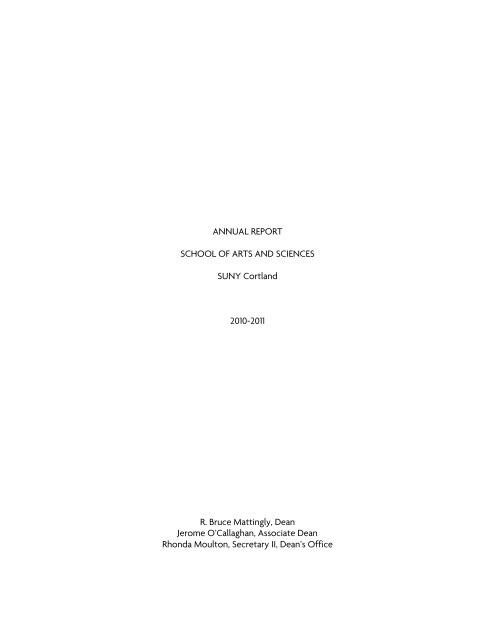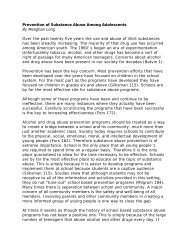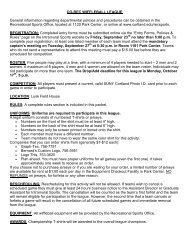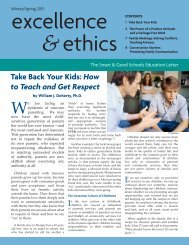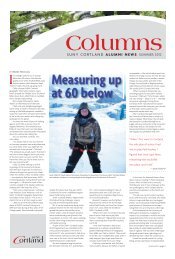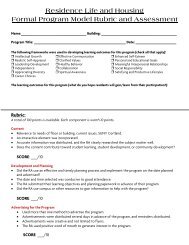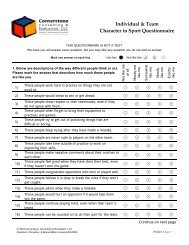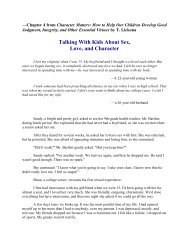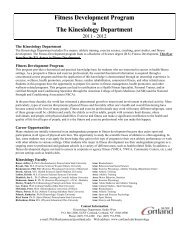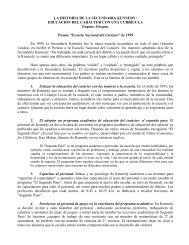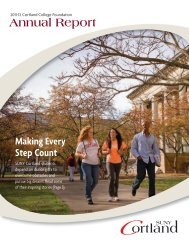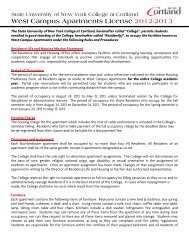Annual Report School of Arts and Sciences 2010 ... - SUNY Cortland
Annual Report School of Arts and Sciences 2010 ... - SUNY Cortland
Annual Report School of Arts and Sciences 2010 ... - SUNY Cortland
You also want an ePaper? Increase the reach of your titles
YUMPU automatically turns print PDFs into web optimized ePapers that Google loves.
ANNUAL REPORTSCHOOL OF ARTS AND SCIENCES<strong>SUNY</strong> Cortl<strong>and</strong><strong>2010</strong>-2011R. Bruce Mattingly, DeanJerome O’Callaghan, Associate DeanRhonda Moulton, Secretary II, Dean’s Office
<strong>Arts</strong> <strong>and</strong> <strong>Sciences</strong> <strong>Annual</strong> <strong>Report</strong> <strong>2010</strong>-2011Table <strong>of</strong> ContentsI. Introduction 3II. Academic Excellence 5A. Enrollment Trends, Faculty Workload 5B. Awards <strong>and</strong> Honors 6C. Assessment activities 10D. Faculty Accomplishments in Teaching 14E. Research, Scholarship, <strong>and</strong> Creative Activity 20F. Faculty Service 22III. Transformational Education 27A. Civic Engagement 27B. Undergraduate Research 27C. Student Teaching <strong>and</strong> Internships 30D. Study Abroad 31E. Other Transformational Experiences 32IV. Well Being 33V. Maximization <strong>of</strong> Resources 38VI. Plans for the Future 42VII. Appendices 44Table 1A: 20 Year History <strong>of</strong> Degrees Granted (OIRA)Table 1B: Fall <strong>2010</strong> Faculty Workload (OIRA)Table 2A: Faculty PublicationsTable 2B: Faculty PresentationsTable 3A: Grant Proposal SubmissionsTable 3B: New Grant AwardsTable 3C: Active Grant AwardsTable 4: <strong>School</strong> <strong>of</strong> <strong>Arts</strong> <strong>and</strong> <strong>Sciences</strong> End <strong>of</strong> Year StatisticsTable 5A: Faculty ServiceDepartmental <strong>and</strong> Individual <strong>Annual</strong> <strong>Report</strong>s
I. Introduction<strong>Arts</strong> <strong>and</strong> <strong>Sciences</strong> <strong>Annual</strong> <strong>Report</strong> <strong>2010</strong>-2011 3In spite <strong>of</strong> additional reductions in faculty <strong>and</strong> staff, the <strong>School</strong> <strong>of</strong> <strong>Arts</strong> <strong>and</strong> <strong>Sciences</strong> once againserved record numbers <strong>of</strong> students <strong>and</strong> made substantial contributions towards addressing each<strong>of</strong> the four campus strategic priorities during the <strong>2010</strong>-11 academic year. Preparing for the Marchsite visit <strong>of</strong> the NCATE Board <strong>of</strong> Examiners was a major priority for faculty <strong>and</strong> staff indepartments that <strong>of</strong>fer teacher preparation programs in adolescence education. We wereencouraged by the approval <strong>of</strong> several searches to fill vacant lines among the full time faculty,<strong>and</strong> faculty members in several departments devoted significant amounts <strong>of</strong> time to reviewingapplications, selecting <strong>and</strong> interviewing finalists for these critical positions. One <strong>of</strong> this year’shighlights was the successful conclusion <strong>of</strong> all twelve <strong>of</strong> our tenure track searches. Otherhighlights included the launch <strong>of</strong> a new undergraduate program in Archaeology, continuedsuccess by our faculty in obtaining external funding, <strong>and</strong> the naming <strong>of</strong> Michael Berzonsky,Psychology as a Distinguished Pr<strong>of</strong>essor.During the year, we said goodbye to several faculty <strong>and</strong> staff members. We congratulate themon their successful careers, thank them for their contributions to <strong>SUNY</strong> Cortl<strong>and</strong>, <strong>and</strong> wish themwell in their future endeavors. In addition to the new faculty who will be joining us in the fall,several new staff members were hired in <strong>2010</strong>-11.Faculty RetirementsBarbara Wisch, Art <strong>and</strong> Art HistoryDavid Hollenback, Communication StudiesJanet Wolf, EnglishWilliam Sharp, HistoryDaniel Driscoll, MathematicsGlen McNeal, Modern LanguagesLarry Ashley, PhilosophyStaff retirementsSue Teeter, Associate Dean’s OfficeDeborah Williams, Communication StudiesKaren Knapp, EnglishArlette Prothin, Modern LanguagesFaculty ResignationsJames Walter, Economics (FTL to part-time)Tina Christodouleas, Modern LanguagesAdrian Hull, Political ScienceNew Tenure-track facultyChrista Chatfield, Biological <strong>Sciences</strong>Jeff Werner, ChemistryFlavia Dantas, EconomicsGuiseppe Getto, English
Sarah Hobson, EnglishRichard Hunter, GeographyLi Jin, GeologyJohn Aerni-Flessner, HistoryLaura Gathagan, HistoryCodruta Temple, Modern LanguagesSonia Sharma, MathematicsLynn Sebastian Purcell, Philosophy<strong>Arts</strong> <strong>and</strong> <strong>Sciences</strong> <strong>Annual</strong> <strong>Report</strong> <strong>2010</strong>-2011 4New Full Time Lecturers <strong>and</strong> Visiting LecturersErika Fowler-Decatur, Art <strong>and</strong> Art HistoryDeborah Rogers, EnglishChristine Lemchak, EnglishMyriam Benincore, Modern LanguagesThomas Heidt, MathematicsQuincy Loney, MathematicsNew Staff MembersMichele Lella, Associate Dean’s <strong>of</strong>ficeMaryalice Griffin, Communication StudiesMolly McGowan, EnglishHaley Zurell, Geology/Physics
II.Academic Excellence<strong>Arts</strong> <strong>and</strong> <strong>Sciences</strong> <strong>Annual</strong> <strong>Report</strong> <strong>2010</strong>-2011 5A. Enrollment Trends <strong>and</strong> Faculty WorkloadIn fall <strong>2010</strong>, 2658 undergraduates <strong>and</strong> 151 graduate students were enrolled in the <strong>School</strong> <strong>of</strong> <strong>Arts</strong><strong>and</strong> <strong>Sciences</strong>. The comparable numbers from fall 2009 were 2645 <strong>and</strong> 154, respectively. Amongthe three schools, A&S has the largest undergraduate population (44% <strong>of</strong> the total) but thesmallest graduate population (16%). While enrollments have remained stable over the last couple<strong>of</strong> years, the school has seen significant growth in student numbers over the last decade, <strong>and</strong> at afaster rate than the rest <strong>of</strong> the college. This growth is also reflected in the number <strong>of</strong> degreesgranted. The number <strong>of</strong> undergraduate degrees awarded from <strong>Arts</strong> <strong>and</strong> <strong>Sciences</strong> grew from 398in the 1999-2000 academic year to 638 in 2009-10, an increase <strong>of</strong> 60%. In the same time frame,the total number <strong>of</strong> undergraduate degrees awarded at <strong>SUNY</strong> Cortl<strong>and</strong> increased 36%, from 1090to 1478. Some departments have experienced particularly sharp increases. For instance, thenumber <strong>of</strong> majors in Biological <strong>Sciences</strong> increased from 165 to 313 over the last ten years, <strong>and</strong> inMathematics, the number <strong>of</strong> majors has increased from 176 to 272 in just five years.At the same time that student enrollments have been increasing, full time faculty numbers havedeclined. From fall 2009 to fall <strong>2010</strong> the number <strong>of</strong> full time faculty in <strong>Arts</strong> <strong>and</strong> <strong>Sciences</strong>decreased from 177 to 172, while the number <strong>of</strong> part time faculty went up from 155 to 166. (Note:because <strong>of</strong> sabbatical leaves <strong>and</strong> other leaves <strong>of</strong> absence, the number <strong>of</strong> full time facultyreported in the faculty workload reports for fall 2009 <strong>and</strong> fall <strong>2010</strong> were 172 <strong>and</strong> 162,respectively.) We are looking forward to the addition <strong>of</strong> 12 new tenure-track faculty <strong>and</strong> 6lecturers who will be joining us in fall 2011. However, that news is tempered by the remaining 16vacant full time lines in <strong>Arts</strong> <strong>and</strong> <strong>Sciences</strong> (14 tenure-track, 2 FTL). In addition, we have not hadthe opportunity in recent years to address the need for new lines in departments that haveexperienced significant growth due to the addition <strong>of</strong> new programs in the last decade. Thedecrease in the number <strong>of</strong> tenure-track faculty has translated into higher advisement loads, moreservice responsibilities, <strong>and</strong> in some cases, larger class sizes. Our recent NCATE re-accreditationeffort placed additional dem<strong>and</strong>s <strong>of</strong> time <strong>and</strong> effort on faculty, staff <strong>and</strong> administrators.Leaves <strong>of</strong> AbsenceAngela Pagano, Biological <strong>Sciences</strong> (Fall <strong>2010</strong> – Drescher Award)Nicola Morris, English (Fall <strong>2010</strong>)Tina Christodouleas, Modern Languages (Fall <strong>2010</strong>, Spring 2011)Aphrodite Ahmadi, Physics (Fall <strong>2010</strong>)Sabbatical leavesFall <strong>2010</strong>Charles Heasley, Art <strong>and</strong> Art HistoryKarla Alwes, EnglishDenise Knight, English *Brett Troyan, History *Leslie Eaton, PsychologyAnne Vittoria, Sociology/Anthropology
Michael Wolfin, ChemistryThomas Breitfeller, PsychologyMichael Curry, PsychologyAm<strong>and</strong>a Zezima, Psychology* Emily’s work was also chosen for the exhibition poster<strong>Arts</strong> <strong>and</strong> <strong>Sciences</strong> <strong>Annual</strong> <strong>Report</strong> <strong>2010</strong>-2011 7The College Writing Committee recognized the following students from across the college asfinalists in the Tenth <strong>Annual</strong> College Writing Contest:Collin Anderson, Graduate Student, M.A.T. EnglishBrenna Filipello, Junior, Communication StudiesLauren Menchini, Freshman, Pre-MajorAmie Whitlock, Senior, Geology <strong>and</strong> Environmental ScienceTaylor Morris, Junior, Pr<strong>of</strong>essional WritingSarah Kane, Senior, EnglishJames Reardon, Graduate Student, M.A.T. EnglishSeveral departments reported on additional student recognition activities from the past year:• Art <strong>and</strong> Art History: One student was invited to exhibit work at the SchweinfurthMuseum, Auburn; two students were honored as <strong>SUNY</strong> Artists <strong>of</strong> the Week, <strong>and</strong> twostudents were selected for the Best <strong>of</strong> <strong>SUNY</strong> exhibition.• English: Twenty students were inducted into Sigma Tau Delta, the English HonorSociety.• International Studies: Four students were inducted into the Phi Beta Delta HonorSociety.• Mathematics: Three math majors were inducted into Tau Sigma (national honor societyfor transfer students), two were inducted into Alpha Sigma Lambda (national honorsociety for non-traditional students), <strong>and</strong> nine were invited to become members <strong>of</strong> thePhi Kappa Phi National Honor Society.• Political Science: Sixteen students were inducted into the Cortl<strong>and</strong> chapter <strong>of</strong> PiSigma Alpha, the national political science honors society. Andrea Forward was one <strong>of</strong>only six students selected nationally to receive a Pi Sigma Alpha Scholarship to supporther internship in Washington.• Psychology: Twenty-six students (majors <strong>and</strong> minors) were inducted into Psi Chi, theInternational Psychology Honor Society.• Sociology <strong>and</strong> Anthropology: A total <strong>of</strong> thirty-three students in three majors (SOC,CRM, ANT) were inducted into national honor societies in <strong>2010</strong>-11.Faculty <strong>and</strong> Staff RecognitionWe are very proud <strong>of</strong> the quality <strong>of</strong> the faculty <strong>and</strong> staff within the school <strong>of</strong> <strong>Arts</strong> <strong>and</strong> <strong>Sciences</strong>,many <strong>of</strong> whom have been recognized by <strong>SUNY</strong> for excellence in research, teaching <strong>and</strong> service.Our current ranks include the following:
<strong>Arts</strong> <strong>and</strong> <strong>Sciences</strong> <strong>Annual</strong> <strong>Report</strong> <strong>2010</strong>-2011 8• 3 Distinguished Pr<strong>of</strong>essors• 8 Distinguished Teaching Pr<strong>of</strong>essors• 4 Distinguished Service Pr<strong>of</strong>essors• 7 Chancellor’s Award Winners for Excellence in Scholarship <strong>and</strong> Creative Activities• 19 Chancellor’s Award Winners for Excellence in Teaching• 1 Chancellor’s Award Winner for Excellence in Faculty Service• 1 Chancellor’s Award Winner for Excellence in Pr<strong>of</strong>essional ServiceFaculty <strong>and</strong> staff recognized by <strong>SUNY</strong> this year include the following:• Deborah Dintino, Africana Studies <strong>and</strong> Political Science, 2011 <strong>SUNY</strong> Chancellor’s Awardfor Excellence in Classified Service.• Christopher McRoberts, Geology, 2011 Chancellor’s Award for Excellence inScholarship <strong>and</strong> Creative Activities• Michael Berzonsky, Psychology, Distinguished Pr<strong>of</strong>essor• Richard Kendrick, Sociology <strong>and</strong> Anthropology, 2011 Chancellor's Award for Excellencein Faculty ServiceMany other faculty members were recognized for their achievements <strong>and</strong> expertise this year,including the following:Vaughn R<strong>and</strong>all, Art <strong>and</strong> Art History, was selected to participate in the largest iron pour inhistory in Detroit MI as part <strong>of</strong> a production designed by conceptual artist Matthew Barney.Michael Hough, Biological <strong>Sciences</strong>, received a Non-Tenure Track Excellence in TeachingAward from the <strong>SUNY</strong> Cortl<strong>and</strong> Faculty Development Center.Greg Phelan, Chemistry, received three awards this year:• <strong>SUNY</strong> Cortl<strong>and</strong> President’s Award for Funded Research, 2011• Excellence in Research, Scholarship, <strong>and</strong> Outreach. 2011• USASBE Outst<strong>and</strong>ing Service as Conference Track Chair Award, 2011John Hartsock, Communication Studies, was awarded a Visiting Pr<strong>of</strong>essorship at the University<strong>of</strong> Paris, where he taught in September <strong>and</strong> October <strong>2010</strong>.Caroline Kaltefleiter, Communication Studies, received a 2009-2011 Mary Lily ResearchFellowship-Duke University, Durham, North CarolinaKathleen Burke, Economics, received the Stephen J. Barnes Outst<strong>and</strong>ing Faculty MemberAward from the Student Government Association.Emmanuel Nelson, English: Nelson’s two-volume Encyclopedia <strong>of</strong> Contemporary LGBTQLiterature <strong>of</strong> the United States was named a <strong>2010</strong> Outst<strong>and</strong>ing Academic Title by Choice.Mary Lynch Kennedy, English, earned the <strong>2010</strong> Educator <strong>of</strong> Excellence Award from New York
State English Council.<strong>Arts</strong> <strong>and</strong> <strong>Sciences</strong> <strong>Annual</strong> <strong>Report</strong> <strong>2010</strong>-2011 9Debra Brown, English, Lecturer II, was selected for a Non-Tenure Track Excellence in TeachingAward by the <strong>SUNY</strong> Cortl<strong>and</strong> Faculty Development Center.Wendy Miller, Geography, received the Excellence in Teaching Award for Tenure Track Facultyfrom the Faculty Development Center.Kevin Sheets, History, received an Excellence in Research <strong>and</strong> Scholarship Award, <strong>SUNY</strong>Cortl<strong>and</strong>, May 2011.Judith Van Buskirk, History, was awarded a West Point Summer Seminar in Military HistoryFellowship. She also received recognition this year for her 2003 book, Generous Enemies. In arecently published book titled Unnatural Rebellion: Loyalists in New York City during theRevolution, the author Ruma Chopra, wrote, “I am flattered when I am asked to place my work inrelation to Judith Van Buskirk’s Generous Enemies. Her warmth <strong>and</strong> goodness are, <strong>of</strong> course,legendary.”Robert Spitzer, Political Science, in the aftermath <strong>of</strong> the Arizona shooting was interviewed onMSNBC, NPR’s “Fresh Air with Terry Gross,” in media outlets in Spain, the Ukraine, <strong>and</strong> Norway,<strong>and</strong> quoted in national media including the New York Times.Richard Kendrick, Sociology/Anthropology was included in the 2011 U.S. President’s HigherEducation Community Service Honor Roll with DistinctionTiantian Zheng, Sociology/Anthropology, received two awards:• 2011 <strong>SUNY</strong> Cortl<strong>and</strong> Outst<strong>and</strong>ing Achievement in Research Award• <strong>2010</strong> Sara Whaley Book Award from the National Women's Studies AssociationThe following faculty received promotions this year:Assistant Pr<strong>of</strong>essor to Associate Pr<strong>of</strong>essor:Elizabeth Kim Stone, EnglishScott Mor<strong>and</strong>a, HistoryMoataz Emam, PhysicsChristopher Latimer, Political ScienceStephen Halebsky, Sociology/AnthropologyMark Worrell, Sociology/AnthropologyAssociate Pr<strong>of</strong>essor to Full Pr<strong>of</strong>essor:Caroline Kaltefleiter, Communication StudiesR<strong>and</strong>i Storch, HistorySharon Steadman, Sociology/Anthropology
Lecturer II to Lecturer IIIMichael Von Tersch, Chemistry<strong>Arts</strong> <strong>and</strong> <strong>Sciences</strong> <strong>Annual</strong> <strong>Report</strong> <strong>2010</strong>-2011 10Faculty receiving Continuing Appointment:Martine Barnaby, Art <strong>and</strong> Art HistoryJennifer McNamara, Art <strong>and</strong> Art HistoryKaren Stearns, EnglishElizabeth Kim Stone, EnglishScott Mor<strong>and</strong>a, HistoryDonna West, Modern LanguagesBrice Smith, PhysicsStephen Halebsky, Sociology/AnthropologyMark Worrell, Sociology/AnthropologyC. Assessment Activities<strong>SUNY</strong> Program ReviewFour departments completed the <strong>SUNY</strong> 7-year Program Review in Spring 2011:• Art <strong>and</strong> Art History• Chemistry• English• Modern Languages (originally scheduled for spring 2009)The complete program review documents from each department are available in the <strong>Arts</strong> <strong>and</strong><strong>Sciences</strong> Dean’s Office <strong>and</strong> include information on curriculum, facilities, faculty qualifications,assessment <strong>of</strong> student learning, as well as comments from external reviewers.Two departments (Communication Studies <strong>and</strong> Physics) were also scheduled for program reviewthis year but did not complete it.NCATEAll adolescence education programs submitted SPA reports in spring <strong>2010</strong> <strong>and</strong> receivedreviewers’ reports in summer <strong>2010</strong>. The results were as follows:Undergraduate ProgramsRecognized:Recognized with Conditions:Recognized with Probation:Further Development Required:Graduate ProgramsRecognized with Conditions:Recognized with Probation:EnglishFrench, Spanish, TESOLMathematicsBiology, Chemistry, Earth Science, PhysicsEnglishMathematics
Further Development Required:<strong>Arts</strong> <strong>and</strong> <strong>Sciences</strong> <strong>Annual</strong> <strong>Report</strong> <strong>2010</strong>-2011 11Biology, Chemistry, Earth Science, PhysicsEach program that did not receive full recognition submitted a revised SPA report in March 2011after making programmatic changes based on the reviewers’ comments. The programs inAdolescence Science made changes to several <strong>of</strong> their assessment instruments. The MathematicsDepartment reported that in response to feedback on the SPA report from the National Council<strong>of</strong> Teachers <strong>of</strong> Mathematics (NCTM) they made significant changes to data collected in studentportfolios related to unit plans, classroom management <strong>and</strong> impact on student learning.Assessment activities are now embedded in three courses (AED 392, 492 <strong>and</strong> 493) making it easierfor the department to enforce completion <strong>of</strong> the portfolio as a graduation requirement. TheModern Languages department also made significant changes to their data collection in responseto feedback from the American Council on the Teaching <strong>of</strong> Foreign Languages (ACTFL). Finally,the Social Studies program invested significant time <strong>and</strong> effort to align their assessment activitieswith the National Council <strong>of</strong> Social Studies (NCSS) st<strong>and</strong>ards.Reviewers’ comments on these revisions are expected in summer 2011. In some cases, preliminaryfeedback from reviewers has been positive. For instance, the coordinators <strong>of</strong> our adolescencescience programs were asked whether one <strong>of</strong> their new assessment documents could be used asan exemplar by the National Science Teachers Association (NSTA).GE AssessmentWhile the General Education committee will submit a separate annual report, the majority <strong>of</strong> GEcourses are delivered in <strong>Arts</strong> <strong>and</strong> <strong>Sciences</strong>. Many A&S faculty members are involved in assessingGE categories, scoring the assessments <strong>and</strong> reviewing the results.Fall <strong>2010</strong>: The GE committee distributed the results <strong>of</strong> assessments conducted in spring <strong>2010</strong> inthe following categories:Humanities (GE 7)Basic Communication: Writing (GE 10a)Prejudice <strong>and</strong> Discrimination (GE 11)Critical ThinkingFaculty involved in teaching courses from these categories will review the results <strong>of</strong> the GEassessments to determine whether any changes in these courses should be recommended.The following categories were assessed in spring 2011:Quantitative Skills (GE 1)United States History <strong>and</strong> Society (GE 4)The <strong>Arts</strong> (GE 8)Foreign Language (GE 9)Basic Communication: Presentation Skills (GE 10b)Additional Assessment ActivitiesAssociate Dean: Each year the Associate Dean’s report lists the data provided in Table 4,
<strong>Arts</strong> <strong>and</strong> <strong>Sciences</strong> <strong>Annual</strong> <strong>Report</strong> <strong>2010</strong>-2011 12including statistics on probation, warning, suspension <strong>and</strong> dismissal, as well as the number <strong>of</strong>students who were readmitted or named to the dean’s list. Dismissals over the last 4 years havehovered between 11 <strong>and</strong> 15. The number <strong>of</strong> students on probation remains steady, from 185 (2007-08) to 164 (2008-09) to 151 (2009-10) to 163 (<strong>2010</strong>-11). The data on suspensions are more central, <strong>and</strong>in the last four years we have seen a decline in suspensions from 144 to 113. This is an encouragingdevelopment, which may reflect the strength <strong>of</strong> advising in the school generally <strong>and</strong> in theAssociate Dean’s <strong>of</strong>fice.Biological <strong>Sciences</strong>: Five students reported their GRE scores to the department. The averagepercentiles for these students on the General GRE exams were Verbal = 52, Quantitative = 47, <strong>and</strong>Analytical writing = 26. These are reasonable but not outst<strong>and</strong>ing scores in comparison to otherseniors pursuing graduate study. The department is exploring opportunities to assist students inpreparing for these exams. The department also administered the ETS Major Field Test in Biologyto 3 r<strong>and</strong>omly chosen students in May <strong>2010</strong>. Their total scores were 171, 169, <strong>and</strong> 158; scores <strong>of</strong> 168-171 rank in the 85th percentile <strong>and</strong> scores <strong>of</strong> 158-159 rank in the 60th percentile. These test scoresare consistent with the dozens <strong>of</strong> scores (median 168) collected over the past 9 years. The testwas administered to another set <strong>of</strong> students in May 2011 but their scores are not yet available.History: Kevin Sheets, graduate coordinator, was awarded a College Assessment Grant todevelop <strong>and</strong> pilot a department assessment plan keyed to learning outcomes for our graduatestudents. The department committed to pilot a history-major only section <strong>of</strong> HIS 110 to capture acohort <strong>of</strong> majors, assess them at the beginning <strong>of</strong> their program <strong>and</strong> follow them through theiracademic careers. The department chair also performs exit interviews with graduating seniors inboth the fall <strong>and</strong> the spring semesters.Modern Languages: The department reported the following assessment results:• Comprehensive examination for MSED students: 10 out <strong>of</strong> 14 students passed in fall <strong>2010</strong>;9 out <strong>of</strong> 10 passed in spring 2011.• All Adolescence French <strong>and</strong> Spanish students who completed student teaching met orexceeded expectations. In Fall <strong>2010</strong>, 5 out <strong>of</strong> 13 exceeded expectations, <strong>and</strong> in Spring 20114 out <strong>of</strong> 8 students exceeded expectations.• The department has decided to use the ACTFL Oral Pr<strong>of</strong>iciency Interview (OPI) to assessFrench <strong>and</strong> Spanish majors’ language pr<strong>of</strong>iciency, adopted “Advanced Low” as a minimumscore for secondary teachers (<strong>and</strong> for non-teacher c<strong>and</strong>idate FRE <strong>and</strong> SPA majors), <strong>and</strong>began requiring students in those majors to take the OPI. In fall <strong>2010</strong>, a total <strong>of</strong> 14adolescence education majors took the OPI. The scores are listed below.o Intermediate Mid: 6o Intermediate High: 2o Advanced Low: 4o Advanced Mid: 1o Advanced High: 1• Several MDL faculty members have received training on administering a simulated oralpr<strong>of</strong>iciency interview (SOPI). The department has established a schedule to administerSOPIs to majors early in their program <strong>and</strong> then periodically to prepare them for the OPIprior to graduation.
<strong>Arts</strong> <strong>and</strong> <strong>Sciences</strong> <strong>Annual</strong> <strong>Report</strong> <strong>2010</strong>-2011 13• The department developed a new rubric for assessing students’ cultural knowledge. In fall<strong>2010</strong>, they found that 8 <strong>of</strong> 16 students approached the st<strong>and</strong>ard, 6 met the st<strong>and</strong>ard, <strong>and</strong>2 exceeded the st<strong>and</strong>ard.• Data from Career Services indicates that among 59 students who graduated between2004 <strong>and</strong> 2009, 58% were employed in their field within a year <strong>of</strong> graduation, another 14%were employed elsewhere, 17% chose to continue their education, <strong>and</strong> only 8% were stillseeking employment one year after graduation. These graduates also reported a highlevel <strong>of</strong> satisfaction with the quality <strong>of</strong> teaching <strong>and</strong> advisement in the major.Performing <strong>Arts</strong>: The department continued an initiative begun last year, in which facultymeet with majors individually at the end <strong>of</strong> the freshman <strong>and</strong> sophomore years to discuss theirprogress in the program. Beyond <strong>SUNY</strong> Cortl<strong>and</strong>, several students have performed in regionaltheatres including the Tibbits Opera House in Michigan, Northern Lights Theatre in Wisconsin,Woodstock Theatre in Woodstock, NY, the Muhlenberg Summer Music Theatre in Allentown,PA, <strong>and</strong> the Merry-Go-Round Playhouse in Auburn. After <strong>of</strong>fering the new musical skills courses(MUS 105/106), which completed its first full year this year, the department has begun discussionsto establish a pr<strong>of</strong>iciency level for these courses, as well as for piano skills. Even with theincreased focus in this area, some <strong>of</strong> our students are not yet attaining a level adequate forpr<strong>of</strong>essional auditions.Political Science: Department assessment activities included the following:• Data from Career Services indicates 40% <strong>of</strong> graduates reported being “very satisfied” (VS)with the quality <strong>of</strong> teaching, <strong>and</strong> 60% reported they were “satisfied” (S). On access t<strong>of</strong>aculty support in the major, 60% reported VS, 20% S, <strong>and</strong> 20% neutral (N). On quality <strong>of</strong>advisement, the percents were 40% VS, 40% S, <strong>and</strong> 20% N. On the availability <strong>of</strong> facultyoutside <strong>of</strong> class, the numbers were also 40% VS, 40% S, <strong>and</strong> 20% N.• The department collected papers from students who took the department’s newcapstone course/requirement. This data will be analyzed <strong>and</strong> reported on in 2012.• The department administered a new Senior Questionnaire, which was completed by 12out <strong>of</strong> 25 students. Results included the following:o Department advisement: 25% rate it excellent; 42% very good; 25% good.o 83% said that lower-level POL courses helped prepare them for upper-level POLcourses.o 83% reported engaging in at least one internship activity (most students reportedmore than one such activity); 34% studied abroad.o 50% engaged in at least one simulation activity (Moot Court, Model UN, Model EUetc.).o 25% participated in student governance (JRB), <strong>and</strong> 58% in student clubs or relatedactivities.o Nearly every faculty member received positive mention as teachers (Pr<strong>of</strong>. Bestreceived the most plaudits). One student volunteered this comment: “I loved thefaculty <strong>and</strong> every pr<strong>of</strong>essor I had. I am a double major in sport management <strong>and</strong>the faculty there is not even close to as good or caring as the political sciencedepartment.”
<strong>Arts</strong> <strong>and</strong> <strong>Sciences</strong> <strong>Annual</strong> <strong>Report</strong> <strong>2010</strong>-2011 14Psychology: The department collected exit survey data from 55 graduating seniors in May 2011.Responses to selected questions are listed below:• “Overall, what are your impressions <strong>of</strong> the psychology program?” Of the 55 respondents,47 (85%) indicated the program was good, while 1 student response was neutral <strong>and</strong> 7suggested that the program needs improvement. Last year, 72% responded “good” tothis question.• “If you had it to do all over again, would you choose to be a psychology major atCortl<strong>and</strong> College?” (N=55), 46 (85%) indicated ‘yes’, 7 indicated ‘no’ (most indicated that isbecause they now have different career aspirations), <strong>and</strong> two were unsure. Last year, 65%<strong>of</strong> respondents answered “yes”.• Of the 55 seniors graduating in May 2011, 24 applied to graduate school. Of those 24, 16were accepted, 7 were still waiting for a response <strong>and</strong> one student was rejected (butplanning to reapply). Thus, the acceptance rate for those who applied is 67%.D. Faculty Accomplishments in TeachingNew ProgramsThe BA in Archaeology began in fall <strong>2010</strong>, including the first <strong>of</strong>fering <strong>of</strong> a new course: ANT 103(Principles <strong>of</strong> Archaeology) <strong>and</strong> the re-institution <strong>of</strong> the Summer Field <strong>School</strong> led by EllisMcDowell-Loudan in summer 2011. The program currently has five undergraduate majors <strong>and</strong>further growth is expected.The Chemistry Department proposed a new undergraduate major in biochemistry. The programhas received local approval <strong>and</strong> the external reviewers’ report was received in spring 2011. Thenext step in the process will be to seek approval from <strong>SUNY</strong>.The proposed Pr<strong>of</strong>essional Science Master’s (PSM) programs in Advanced Materials (chemistry)<strong>and</strong> Sustainable Energy Systems (physics) received local approval last year. Both departmentsexpect to schedule visits from external reviewers in fall 2011 prior to seeking <strong>SUNY</strong> approval. TheBiological <strong>Sciences</strong> department continued its work in exploring the potential development <strong>of</strong>new master’s PSM proposals.The dual diploma program in economics with Izmir Economics University has now graduated twocohorts <strong>of</strong> 4 students from Izmir, with a third cohort <strong>of</strong> 2 students expected to graduate in 2012.A major concern is that no new students are scheduled to enter the program in fall 2011. Olderversions <strong>of</strong> the articulation agreement with Anadolu University in business economics are nolonger effective in guiding students; nevertheless, this program will produce its first graduate thisyear. A draft <strong>of</strong> a new 2+2 program version <strong>of</strong> the agreement is under development. Oversightfor these programs at <strong>SUNY</strong> Cortl<strong>and</strong> is provided by Lisi Krall <strong>and</strong> German Zarate.Program <strong>and</strong> Course AlterationsIn response to NYSED’s newly m<strong>and</strong>ated certification requirements dealing with students withdisabilities, adolescence education programs in English, social studies, mathematics <strong>and</strong> thesciences added new courses: SPE 275: Teaching Students with Disabilities in Adolescence
<strong>Arts</strong> <strong>and</strong> <strong>Sciences</strong> <strong>Annual</strong> <strong>Report</strong> <strong>2010</strong>-2011 15Classrooms at the undergraduate level <strong>and</strong> SPE 520: Teaching in Inclusive Classrooms at thegraduate level. In some cases, other program requirements were eliminated or restructured toaccommodate the new addition. The adolescence education programs in French, Spanish, <strong>and</strong>TESOL already included PSY 331: Psychology <strong>of</strong> Exceptional Children, which also satisfies theNYSED m<strong>and</strong>ate. All adolescence education programs will be modifying their required fieldexperiences to include at least 15 hours focused on teaching students with disabilities.The Geology Department raised the GPA requirement in area C (Pr<strong>of</strong>essional Preparation) <strong>of</strong> theAES major from a 2.5 to a 3.0 for admission to the program <strong>and</strong> student teaching. In the M.A.T.program, the Geology Department exp<strong>and</strong>ed the GPA expectation so that a 3.0 GPA is requiredin both the graduate geology <strong>and</strong> pedagogy areas. In the M.S.Ed. program, the GeologyDepartment exp<strong>and</strong>ed the GPA expectation so that a 3.0 GPA is required in the major electives,related areas <strong>of</strong> science, <strong>and</strong> the pedagogy areas.The History Department has added a transnational/international category to its upper-levelcourse <strong>of</strong>ferings. In response to changing job markets, the department is also exploring thedevelopment <strong>of</strong> a public history concentration.The Mathematics Department has reduced the number <strong>of</strong> credit hours required for graduationfor MAT majors from 124 to 120. Also starting fall 2011, a grade <strong>of</strong> C- or better in required in anypre-requisite mathematics course. This is consistent with the transfer credit policy <strong>and</strong> willguarantee a certain level <strong>of</strong> pre-requisite knowledge before moving on to subsequent courses.To provide greater consistency in course <strong>of</strong>ferings, outlines for all undergraduate mathematicscourses except for MAT 425 have been developed <strong>and</strong> approved by the department. Theseoutlines have already resulted in some changes to a number <strong>of</strong> course descriptions.The Adolescence Education programs in French <strong>and</strong> Spanish will now include an OPI rating <strong>of</strong>intermediate-high as a prerequisite for enrollment in AED 439, Student Teaching. The ESLprograms <strong>of</strong>fered by the Modern Languages Department will require three new courses: ESL 303,404 <strong>and</strong> 405) <strong>and</strong> will eliminate AED 323.The MSED program in adolescence education physics (APH) has been modified so that graduateswill now automatically qualify for the middle school general science certification which is asignificant advantage for students to have when seeking employment.Program alterations proposed by the Psychology Department have been approved by theprovost <strong>and</strong> will appear in the fall 2011 catalog. To our knowledge, <strong>SUNY</strong> Cortl<strong>and</strong> will house theonly undergraduate psychology program in the <strong>SUNY</strong> system whose curriculum is aligned withthe American Psychological Association guidelines.The course number for Introduction to Middle Childhood Education was changed from EDU 533to AED 533 to reflect the fact that this course will now be <strong>of</strong>fered through the <strong>School</strong> <strong>of</strong> <strong>Arts</strong><strong>and</strong> <strong>Sciences</strong>. Associate Dean O’Callaghan will be responsible for scheduling instructors, as healso does for AED 391 <strong>and</strong> AED 600.
Several courses received approval for new attributes:General EducationCOM 200: Communication History (GE 5)CIN 101: History <strong>of</strong> Cinema I (GE 8)CIN 102: History <strong>of</strong> Cinema II (GE 8)CIN 208: Introduction to Film Analysis (GE 8)COM 100: Human Communication (GE 7)POL 307: The Internet <strong>and</strong> the Law (GE 12)Writing IntensivePOL 229: RevolutionsENG 202: Introduction to Fiction: the Graphic NovelGLY 471: StratigraphyHIS 491/IST 400: Readings: Power in the Modern WorldPOL 329: Comparative DemocracyATH 429: Globalization & Contemporary ArtPSY 404: Applying Research Methods in PsychologyNew coursesAAS 206: Blues Appreciation in CultureCOM 329: Popular CultureCOM 329: Event PlanningENG 617: The PostmodernENG 529: The Postmodern SacredHIS 329: Latin American Revolutions in the 20 th CenturyHIS 429: History <strong>of</strong> Children <strong>and</strong> Youth in AmericaPHI 170: Philosophical Meditations: SomaetheticsPHI 330: Ethics <strong>of</strong> LovePHI 450: Philosophy Teaching AssistantPHY 505: Energy <strong>and</strong> SustainabilityPHY 576: Physics <strong>of</strong> Renewable EnergyPOL 229: RevolutionsPOL 329: Narcotics Policy <strong>and</strong> EnforcementPOL 329: Comparative DemocracyTeaching innovations<strong>Arts</strong> <strong>and</strong> <strong>Sciences</strong> <strong>Annual</strong> <strong>Report</strong> <strong>2010</strong>-2011 16Under the leadership <strong>of</strong> Kathy Lattimore, the Writing Fellows Program again provided assistanceto several faculty members across the college. Fellows were assigned to the following courses:FSA 201 (2 sections), FSA 400, FSA 471, SPE 650, HIS 290, ECE 315 <strong>and</strong> SHH 370. Fellows wererecruited from several departments, including history/social studies; psychology, AdolescenceEducation—English, <strong>and</strong> anthropology/social studies. Several pr<strong>of</strong>essors noted improvement intheir students’ written work as a result <strong>of</strong> the program.
<strong>Arts</strong> <strong>and</strong> <strong>Sciences</strong> <strong>Annual</strong> <strong>Report</strong> <strong>2010</strong>-2011 17Bill Skipper, Sociology <strong>and</strong> Anthropology, served as <strong>SUNY</strong> Cortl<strong>and</strong> coordinator for the <strong>SUNY</strong>Global Workforce Project. Several faculty members, including Ibipo Johnston-Anumonwo, havedeveloped curriculum modules that can be used to introduce international themes into a variety<strong>of</strong> courses. Wendy Miller piloted the Globalization <strong>and</strong> Technology module in GRY 370: Will theWorld Provide (GRY 370). In Modern Languages, Chinese courses <strong>of</strong>fered on the <strong>SUNY</strong> Cortl<strong>and</strong>campus were also taught through videoconferencing to students at <strong>SUNY</strong> Brockport.Faculty members from several departments in <strong>Arts</strong> <strong>and</strong> <strong>Sciences</strong> continued their involvement indeveloping <strong>and</strong> teaching courses in learning communities for freshmen.Art <strong>and</strong> Art History• Instructors <strong>of</strong> studio art courses are making increasing use <strong>of</strong> blogs to reinforce research<strong>and</strong> conversation.• The department is using video recording <strong>and</strong> peer practice to improve students’presentation skills.Biological <strong>Sciences</strong>• The biomedical sciences freshman seminar (BMS 260) was restructured. Instead <strong>of</strong>providing short introductions to a variety <strong>of</strong> areas, the seminar focused on a single topic(malaria) covered in great depth <strong>and</strong> from several perspectives.• Terrence Fitzgerald introduced new laboratory experiences in animal behavior requiringstudents to videotape <strong>and</strong> edit sequences <strong>of</strong> studies on animal behavior.Communication Studies• The department has completed its transition into the acquisition <strong>and</strong> editing <strong>of</strong> High-Definition audio <strong>and</strong> video content in all field production related activities.• This year, the department’s continuing efforts to provide service-learning opportunitiesto students were coupled with efforts to integrate undergraduate research into thecurriculum. During the fall semester, students enrolled in COM 342 Field TelevisionProduction created a series <strong>of</strong> videos promoting study abroad. This project was picked upby Multimedia Production students in the spring <strong>and</strong> resulted in the creation <strong>of</strong> 5 videosstructured around a central theme. In the Spring, students taking COM 350 NewCommunication Media created a lipdub video in support <strong>of</strong> funding for the <strong>SUNY</strong>system.• During his visiting pr<strong>of</strong>essorship at the University <strong>of</strong> Paris in fall <strong>2010</strong>, John Hartsock used anew program called Rich Media, <strong>of</strong>fered by Classroom Media Services, to provide pre-recordedlectures <strong>and</strong> Power Point to students in his COM 400 class.Economics• Tim Phillips used CapSim, a computer simulation tool, in MGT 454: Strategic Management.Students “run” a high tech sensor company that competes against other groups in the
<strong>Arts</strong> <strong>and</strong> <strong>Sciences</strong> <strong>Annual</strong> <strong>Report</strong> <strong>2010</strong>-2011 18class <strong>and</strong> are rated against the other companies in class as well as against as many as 2100other schools from around the world.English• Victoria Boynton designed an on-line version <strong>of</strong> PWR 213: Writing Poetry (GE 8).• Andrea Harbin implemented a podcasting assignment on Middle English pronunciation.Students demonstrated substantial improvement in pronunciation, fluency <strong>and</strong>confidence with Middle English. Also, for ENG 431: Arthurian Literature, she developed awiki as a site for student discussion <strong>and</strong> shared research.• Karen Stearns established nings in ENG 374 <strong>and</strong> ENG 619 where students exchanged ideaswith each other <strong>and</strong> with authors <strong>of</strong> some <strong>of</strong> the books they read for class. Students inENG 619 wrote articles for publication in next issue <strong>of</strong> The English Record.Geography• Wendy Miller <strong>and</strong> Kathleen Burke, Economics, paired students from their two upperdivision courses in collaborative projects. Burke’s Econometrics students “hired” Miller’sAdvanced GIS Techniques students to help analyze their data <strong>and</strong> prepare maps for theirfinal project.History/International Studies• Girish Bhat <strong>and</strong> Sharon Steadman team-taught IST 400/HIS 491 (“Power in ModernWorld”) for the second time.Mathematics• Homework submission in lower level mathematics courses is gradually shifting from inclasspaper submission to online submission using online grading systems such asMyMathLab. Such systems allow faculty to assign more homework that provide studentswith immediate feedback while allowing instructors to focus more on teaching.• Mary Gfeller serves as principal investigator for a Pr<strong>of</strong>essional Development <strong>School</strong> (PDS)collaboration with Jamie Henry <strong>and</strong> Vicki Darrow from the Cortl<strong>and</strong> City <strong>School</strong>s. Insummer <strong>2010</strong> she produced three video clips taken from Jaime Henry’s classroom, one <strong>of</strong>which was used in AED 392. The collaboration will continue in fall 2011 with teacherc<strong>and</strong>idate Melissa Lair selected to work with Jamie Henry in the PDS partnership.Modern Languages• Shena Salvato received a Teaching Innovation Grant that will provide s<strong>of</strong>tware designedto help students in her ESL 403 course Second Language Testing <strong>and</strong> Assessment tovisualize <strong>and</strong> organize complex problems into component parts. This new s<strong>of</strong>tware willhelp students to visualize the process as they work from student learning outcomes to
<strong>Arts</strong> <strong>and</strong> <strong>Sciences</strong> <strong>Annual</strong> <strong>Report</strong> <strong>2010</strong>-2011 19sets <strong>of</strong> skills <strong>and</strong> knowledge leading to such outcomes, <strong>and</strong> finally to instruments forexercising <strong>and</strong> evaluating each such skill or parcel <strong>of</strong> knowledge.• Mark Cerosaletti scheduled the screening <strong>of</strong> Italian films to complement Italian courses.• Hongli Fan taught ESL 400 (Reading in Second Language Classrooms) as a service learningcourse in which pre-service teachers worked with ESL learners from Cortl<strong>and</strong>,Binghamton, <strong>and</strong> Syracuse school districts <strong>and</strong> reflected on their experiences.• Paulo Quaglio taught a new course, ICC 529-501, Online ESL Teaching. This internshipincludes instruction <strong>and</strong> clinical experience in the use <strong>of</strong> new s<strong>of</strong>tware, adaptation <strong>of</strong>teaching techniques, the development <strong>of</strong> a blog, <strong>and</strong> recruitment <strong>of</strong> international ESLlearners.Philosophy• Kathy Russell received a Teaching Innovation Grant to develop special units for SCI 300:Science <strong>and</strong> Its Social Context <strong>and</strong> PHI 110: Critical Thinking <strong>and</strong> Argumentation. The grantalso supported her participation at a week-long summer workshop on media literacyorganized by Project Look Sharp at Ithaca College.Political Science• Mary McGuire <strong>of</strong>fered innovative hybrid-online-in-class curricular <strong>of</strong>ferings.• Bob Spitzer learned WebCT <strong>and</strong> <strong>of</strong>fered a hybrid online course for the first time.Physics• Aphrodite Ahmadi restructured PHY 357: Intermediate Physics Laboratory to include anew focus on inquiry based investigations.• Andrew Carmichael made use <strong>of</strong> online homework systems in several <strong>of</strong> his courses.Psychology• The Psychology Department continues to provide more online course <strong>of</strong>ferings than anyother department except Sport Management.E. Research, Scholarship, <strong>and</strong> Creative ActivityDuring the <strong>2010</strong>-11 academic year, <strong>Arts</strong> <strong>and</strong> <strong>Sciences</strong> faculty continued their high productivity inresearch <strong>and</strong> creative work. As seen in Table 2A, they collectively produced 30 books (14authored <strong>and</strong> 16 edited) along with 53 book chapters, 89 articles in peer-reviewed journals <strong>and</strong> 8plays. Each <strong>of</strong> these represents an increase from the previous year, in which they published 21books, 28 book chapters, 84 articles <strong>and</strong> 5 plays. Among the 162 full time faculty in fall <strong>2010</strong>, 112 <strong>of</strong>them (69%) have published at least one item in the last two years.Two scholarly journals <strong>and</strong> a book series are currently housed at <strong>SUNY</strong> Cortl<strong>and</strong> within the<strong>School</strong> <strong>of</strong> <strong>Arts</strong> <strong>and</strong> <strong>Sciences</strong>. John Hartsock, Communication Studies, serves as editor for theinternational journal Literary Journalism Studies, now in its third year <strong>of</strong> publication. MeckeNagel, Philosophy, serves as editor for Wagadu. The Center for Ethics, Peace, <strong>and</strong> Social Justice(CEPS), under the direction <strong>of</strong> Andrew Fitz-Gibbon, Philosophy, continues to sponsor the series
<strong>Arts</strong> <strong>and</strong> <strong>Sciences</strong> <strong>Annual</strong> <strong>Report</strong> <strong>2010</strong>-2011 20on Social Philosophy in the Rodopi Value Inquiry Book Series. In 2001, CEPS publishedPostethnophilosophy by Sanya Osha including a Guest Foreword by Seth Asumah, AfricanaStudies <strong>and</strong> Political Science.Tim Baroni, Biological <strong>Sciences</strong>, manages the <strong>SUNY</strong> Cortl<strong>and</strong> Herbarium, a major resource forresearchers throughout the world. In <strong>2010</strong>-11, specimens from Cortl<strong>and</strong> were loaned toresearchers at the following universities: Louisiana State, Middle Tennessee State, SouthAlabama, North Carolina State, Oregon, as well as other researchers in New Jersey <strong>and</strong> Austria.A&S faculty also continue to be active participants at scholarly conferences <strong>and</strong> exhibitions, witha total <strong>of</strong> 298 presentations at the international, national, regional or state level. Table 2B showsthat in the last two years, nearly 70% <strong>of</strong> our full time faculty members (including full timelecturers) have made at least one presentation.Faculty from <strong>Arts</strong> <strong>and</strong> <strong>Sciences</strong> were instrumental in organizing two conferences hosted at <strong>SUNY</strong>Cortl<strong>and</strong>. Caroline Kaltefleiter, Communication Studies, <strong>and</strong> Colleen Kattau, Modern Languages,organized the “Reimagining Girlhood Conference” in fall <strong>2010</strong> with over 150 participants from 14countries. Patricia Martinez <strong>and</strong> Paulo Quaglio, Modern Languages, organized the annual SecondLanguage Education conference for foreign language teachers <strong>and</strong> pre-service teachers.The <strong>School</strong> <strong>of</strong> <strong>Arts</strong> <strong>and</strong> <strong>Sciences</strong> had another strong year in obtaining external funding. Tables3A—3C provide summarize the sponsored program activity within the school during the <strong>2010</strong>-11year. A&S faculty wrote <strong>and</strong> submitted 34 proposals, 17 <strong>of</strong> which were funded for a total <strong>of</strong> over$1.5 million. On June 30, 2011, <strong>Arts</strong> <strong>and</strong> <strong>Sciences</strong> had a total <strong>of</strong> 32 active projects across 12departments, including both new <strong>and</strong> continuing awards totaling over $3.2 million. Somehighlights from this year’s externally funded projects are listed below:Kevin Sheets, History, received his third consecutive Teaching American History (TAH) grantfrom the U.S. Department <strong>of</strong> Education for his project “First Person America.” The grant willprovide $332,317 in funding to <strong>SUNY</strong> Cortl<strong>and</strong> over three years for the pr<strong>of</strong>essional development<strong>of</strong> social studies teachers. Sheets will have primary responsibility for the design <strong>and</strong>implementation <strong>of</strong> the history-related content <strong>of</strong> our pr<strong>of</strong>essional development activities for 72K-12 teachers across 24 school districts.Sharon Steadman, Sociology/Anthropology, was awarded a National Science Foundationgrant (2011-14) for her archaeological research in Turkey entitled “Frontier <strong>and</strong> Empire on theCentral Anatolian Plateau: Transitions at Cadir Hoyuk” in the amount <strong>of</strong> $296,240.Greg Phelan, Chemistry, received a new grant from the National Science Foundation (withcollaborators from two other institutions) to establish a northeast Noyce Scholarship RegionalConference. The grant will provide $166,098 in funding to <strong>SUNY</strong> Cortl<strong>and</strong>. Phelan also published16 patent applications this year.Richard Kendrick, Sociology/Anthropology, Richard Kendrick received $154,000 from theCorporation for National <strong>and</strong> Community Service for the 3 rd year <strong>of</strong> the <strong>SUNY</strong> Cortl<strong>and</strong>AmeriCorps program.
<strong>Arts</strong> <strong>and</strong> <strong>Sciences</strong> <strong>Annual</strong> <strong>Report</strong> <strong>2010</strong>-2011 21Theresa Curtis, Biological <strong>Sciences</strong>, received $77,147 from the U.S. Army Center forEnvironmental Health Research for her project “Development <strong>of</strong> the Environmental SentinelBiomonitor (ESB) System.”David Franke, English, received $46,000 in matching funds from the U.S. Department <strong>of</strong>Education to support the Seven Valleys Writing Project during the <strong>2010</strong>-11 year.Henry Steck, Political Science, was awarded $15,000 from the U.S. Department <strong>of</strong> Education forthe “Mobility Project: Transatlantic Public Administration.”Bruce Mattingly, Dean’s Office, Peter Ducey, Biological <strong>Sciences</strong>, Greg Phelan, Chemistry,<strong>and</strong> Brice Smith, Physics were awarded $9724 from the Sloan Foundation for a second planninggrant for the development <strong>of</strong> Pr<strong>of</strong>essional Science Masters programs.Caroline Kaltefleiter, Communication Studies, received a $5000 Conversations in theDisciplines (CID) Grant from <strong>SUNY</strong> to support the Reimagining Girlhood Conference.Denise Knight, English, received a $400 research travel grant from the Radcliffe Institute forAdvanced Study at Harvard University.Listed below are the internal grants awarded this year to <strong>Arts</strong> <strong>and</strong> <strong>Sciences</strong> faculty:Dr. Nuala McGann Drescher Affirmative Action/Diversity Leave Program AwardAngela Pagano, Biological <strong>Sciences</strong> (Fall <strong>2010</strong>)Faculty Research Program Awards (2011-12):Robert Darling, GeologyScott Mor<strong>and</strong>a, HistoryBrett Troyan, HistoryAphrodite Ahmadi, PhysicsResearch Travel Grants:Biru Paul, EconomicsAndrea Harbin, EnglishStephen Halebsky, Sociology/AnthropologyF. Faculty ServiceTable 5A summarizes faculty participation in service activities. In addition to department-levelservice, <strong>Arts</strong> <strong>and</strong> <strong>Sciences</strong> faculty filled 55 committee <strong>and</strong> other service positions at the schoollevel <strong>and</strong> 302 at the college level (as compared with 250 the previous year). Beyond campus,
<strong>Arts</strong> <strong>and</strong> <strong>Sciences</strong> <strong>Annual</strong> <strong>Report</strong> <strong>2010</strong>-2011 22faculty collectively held 111 service positions in pr<strong>of</strong>essional organizations, 16 provided service toP-12 schools, <strong>and</strong> 104 reported involvement in community-based service. Overall, 151 <strong>of</strong> our 168full time faculty (85%) reported some form <strong>of</strong> service activity during the <strong>2010</strong>-2011 academic year.The participation rate in 2009-10 was 78%. The <strong>School</strong> <strong>of</strong> <strong>Arts</strong> <strong>and</strong> <strong>Sciences</strong> continues to providesignificant leadership across the college. Some <strong>of</strong> the highlights in service are listed below:Department ChairsAfricana StudiesSeth AsumahArt <strong>and</strong> Art HistoryLori EllisBiological <strong>Sciences</strong> Peter Ducey *ChemistryGregory PhelanCommunication StudiesPaul van der VeurEconomicsGerman ZarateEnglishMatthew LessigGeographyScott AndersonGeologyRobert DarlingHistoryR<strong>and</strong>i StorchMathematicsIsa JubranModern LanguagesChristopher GascónPerforming <strong>Arts</strong>David NealPhilosophyKathryn RussellPhysicsBrice SmithPolitical ScienceRobert SpitzerPsychology Judith Ouellette *Sociology/AnthropologyWilliam Skipper* A&S representative to Academic Affairs CouncilProgram CoordinatorsInternational StudiesEnvironmental ScienceAsian <strong>and</strong> Middle Eastern StudiesJewish StudiesLatino <strong>and</strong> Latin American StudiesNative American StudiesWomen’s StudiesSharon Steadman, Sociology/AnthropologyDavid Barclay, GeologyTiantian Zheng, Sociology/AnthropologyHenry Steck, Political ScienceSusan Peterson, Modern LanguagesEllie McDowell-Loudan, Sociology/AnthropologyCaroline Kaltefleiter, Communication StudiesAdolescence Education CoordinatorsEnglishCynthia SarverMathematicsDavid DickersonModern LanguagesCodruta Temple<strong>Sciences</strong>Rena Janke <strong>and</strong> Angela PaganoSocial StudiesJohn SheddGraduate CoordinatorsEnglish Andrea Harbin (fall <strong>2010</strong>), Kim Stone (spring 2011)
HistoryMathematicsModern Languages<strong>Arts</strong> <strong>and</strong> <strong>Sciences</strong> <strong>Annual</strong> <strong>Report</strong> <strong>2010</strong>-2011 23Kevin SheetsJalal AlemzadehColleen KattauAdditional College <strong>and</strong> Pr<strong>of</strong>essional Organization Leadership PositionsBiological <strong>Sciences</strong>• Tim Baroni: Chair <strong>of</strong> Finance Committee in Mycological Society <strong>of</strong> America• Peter Ducey: Chair, College Research Committee• Rena Janke, A&S Representative to NCATE Executive Steering Committee• Angela Pagano: Area Representative to Science Teachers Association <strong>of</strong> NYS• John Sternfeld, Faculty Representative, Facilities Master Plan Oversight Committee• Mary Beth Voltura, Chair, Institutional Animal Care <strong>and</strong> Use CommitteeChemistry• Greg Phelan: Co-chair, Special Interest group, United States Association <strong>of</strong> Small Business<strong>and</strong> EntrepreneurshipCommunication Studies• Caroline Kaltefleiter: 2011 Creative Project Director—Sacco & Vanzetti Foundation• Sam Kelley: Faculty Advisor, <strong>SUNY</strong> Cortl<strong>and</strong> Gospel Choir• Kathleen Lawrence: Treasurer, Faculty Senate• Tom Mwanika: Chair, Presentation Skills CommitteeEconomics• Kathleen Burkeo Co-director, Cortl<strong>and</strong> Center for Economic Educationo President, Academy <strong>of</strong> Process Education• Lisi Krall, Coordinator, dual degree programs• Tim Phillipso Co-director, Cortl<strong>and</strong> Center for Economic Educationo Vice Chair, Faculty SenateEnglish• Karla Alwes, editor <strong>and</strong> contributing writer, The Cortl<strong>and</strong> Cause• Alex Gonzalez, Chair, Fine <strong>Arts</strong> & Humanities Subschool Personnel Committee• Andrea Harbin, Manager <strong>of</strong> www. NetSerf.org• Mary Lynch Kennedy, Campus Writing Coordinator & Director <strong>of</strong> CompositionGeography• David Miller: Chair, Faculty Senate
Geology• Gayle Gleasono Chair, Math-Science Subschool Personnel Committeeo Chair, College Appeals Committeeo Co-chair, Women’s Initiatives Committee• Chris McRoberts, Chair, Undergraduate Research Council<strong>Arts</strong> <strong>and</strong> <strong>Sciences</strong> <strong>Annual</strong> <strong>Report</strong> <strong>2010</strong>-2011 24History• R<strong>and</strong>i Storcho Executive Board Member, Labor <strong>and</strong> Working Class History Associationo Chair, Teaching Resources Committee, Labor <strong>and</strong> Working Class HistoryAssociation• Girish Bhat, <strong>2010</strong>-2011 president <strong>of</strong> campus chapter <strong>of</strong> Phi Kappa Phi• Amy Schutt: <strong>SUNY</strong> Cortl<strong>and</strong> liaison to Tomkins-Cortl<strong>and</strong> Community CollegeMathematics• Isa Jubran: Chair, Quantitative Skills committee• Mary Gfeller: Co-chair, Honors Convocation committeeModern Languages• Robert Ponterio, Co-owner <strong>and</strong> Moderator, web.cortl<strong>and</strong>.edu/flteachPerforming <strong>Arts</strong>• Ralph Dudgeono Campus representative, College Music Societyo President, Interfaith BoardPhilosophy• Andrew Fitz-Gibbono Chair, Academic Faculty Affairs Committeeo Director, Center for Ethics, Peace <strong>and</strong> Social Justice• Mecke Nagel, Director, Center for Intercultural <strong>and</strong> Gender StudiesPhysics• Moataz Emam, Faculty Advisor, Martial <strong>Arts</strong> Club• Brice Smith, Faculty Advisor, Physics <strong>and</strong> Engineering Club the Environmental ScienceClubPolitical Science• Robert Spitzer: Chair, Educational Policy Committee• Chris Latimer, Associate Director, Institute for Civic Engagement• Mary McGuire, Chair, <strong>Arts</strong> <strong>and</strong> <strong>Sciences</strong> Curriculum Committee• Tom Pasquarello, Coordinator, Belize Zoo Project
<strong>Arts</strong> <strong>and</strong> <strong>Sciences</strong> <strong>Annual</strong> <strong>Report</strong> <strong>2010</strong>-2011 25Psychology• David Berger, chair, Social <strong>Sciences</strong> Subschool Personnel CommitteeSociology/Anthropology• Jamie Danglero President <strong>of</strong> Cortl<strong>and</strong>'s UUP Chaptero Chief UUP contract negotiator• Richard Kendrick, Director, Institute for Civic Engagement• Sharon Steadman: Director, Brooks MuseumDean’s Office:• Jerome O’Callaghan: Chair, <strong>SUNY</strong> Deans <strong>of</strong> <strong>Arts</strong> <strong>and</strong> <strong>Sciences</strong>
III.Transformational Education<strong>Arts</strong> <strong>and</strong> <strong>Sciences</strong> <strong>Annual</strong> <strong>Report</strong> <strong>2010</strong>-2011 26A. Civic EngagementWhile the Institute for Civic Engagement continues to be the natural focal point for projects inthis area, several other departments reported on additional significant activities during the year:• Faculty members from the Art <strong>and</strong> Art History department curated exhibitions at theBeard Gallery on Main Street, enriching the cultural life <strong>of</strong> the community.• The sculpture program, under the direction <strong>of</strong> Vaughn R<strong>and</strong>all, sponsored severalcommunity outreach events.• Students from the Communication Studies department participated in Dr. Syed Pasha’s<strong>Annual</strong> Campus Community Clean Up during the spring 2011 semester.• Paul van der Veur, Communication Studies, integrated service learning components intoCOM 110 <strong>and</strong> COM 342. Students in these courses used their media production skills tosupport a number <strong>of</strong> campus <strong>and</strong> community service organizations as part <strong>of</strong> their courserequirements. This allowed them the opportunity <strong>of</strong> honing their ‘real world’ productionskills while giving back to their communities.• Caroline Kaltefleiter’s students in COM 350 produced the 2011 <strong>SUNY</strong> Cortl<strong>and</strong> LipdubProject, a four-minute video that addresses rising costs <strong>of</strong> an education <strong>and</strong> a message <strong>of</strong>social change to “Save <strong>SUNY</strong>.”• The Cortl<strong>and</strong> Center for Economic Education engaged several students in the Volunteersin Tax Assistance Program, in which students train with the Cornell Cooperative ExtensionOffice <strong>and</strong> the Internal Revenue Service to become tax preparers to assist people <strong>of</strong>modest means in filing their income tax forms.• Scott Mor<strong>and</strong>a, History, joined other faculty <strong>and</strong> students from the History Club in aMcGraw cemetery clean up.• Hongli Fan, Modern Languages, taught ESL 400 (Reading in Second Language Classrooms)as a service learning course in which pre-service teachers worked with ESL learners fromCortl<strong>and</strong>, Binghamton, <strong>and</strong> Syracuse school districts <strong>and</strong> reflected on their experiences.B. Undergraduate ResearchIn the Art <strong>and</strong> Art History Department <strong>Annual</strong> <strong>Report</strong>, chair Lori Ellis describes undergraduateresearch as “central to all <strong>of</strong> the art studio programs in the Department. From foundation courseto senior culminating experiences, students are encouraged to develop independent creativethought <strong>and</strong> to manifest their creativity in concrete projects <strong>of</strong> their own design.” Culminatingexperiences include group <strong>and</strong> solo exhibitions, the BFA thesis exhibition, <strong>and</strong> the New MediaDesign portfolio website.The Biological <strong>Sciences</strong> Department enrolled 19 students in research courses during Fall <strong>2010</strong> <strong>and</strong>another 16 in research courses in Spring 2011, representing a total <strong>of</strong> 29 students enrolled in somekind <strong>of</strong> research course for at least one semester. Ten <strong>of</strong> the department‘s 14 tenure-trackfaculty members supervised research students. The student enrollments for research with other
<strong>Arts</strong> <strong>and</strong> <strong>Sciences</strong> <strong>Annual</strong> <strong>Report</strong> <strong>2010</strong>-2011 27faculty were Broyles (4), Conklin (3), Curtis (7), Ducey (4), Fitzgerald (2), Gatto (2), Klotz (2), Pagano(4), Sternfeld (1), <strong>and</strong> Straneva (3). In addition, three students received <strong>2010</strong> SummerUndergraduate Research Fellowships. The students were Kellyanne Hearn, Mike Wolfin, <strong>and</strong> LauraPlatt with supervisors Ducey, Fitzgerald, <strong>and</strong> Klotz, respectively. Several faculty membersprovided salaries for student research with funding from grants <strong>and</strong> other outside sourcesincluding Conklin (2 students), Curtis (1 student), Ducey (2 students), <strong>and</strong> Fitzgerald (1 student).During the past year, twelve Chemistry students (both undergraduate <strong>and</strong> graduate) wereinvolved in research. These students worked in laboratories, running samples on the instruments,<strong>and</strong> read scientific journal articles describing peer reviewed research occurring at other placesaround the world.Several students in Communication Studies experimented with the application <strong>of</strong> variouscompressing <strong>and</strong> decompression algorithms to most effectively stream media content over thecampus network. Other students researched the social implications <strong>of</strong> new communicationtechnologies as well as media manipulation <strong>of</strong> societal events. Alumnus Andrew Hamiltonreceived credit in the Acknowledgments section <strong>of</strong> John Hartsock’s book Seasons <strong>of</strong> a FingerLakes Winery for his assistance in analyzing the kinds <strong>of</strong> licenses Finger Lakes Wineries have, <strong>and</strong>the kinds <strong>of</strong> grape varieties they grow.Economics major Michael Tota assisted Kathleen Burke in a study <strong>of</strong> salary compression data inhigher education, culminating in a Scholars’ Day presentation <strong>and</strong> the development <strong>of</strong> twomanuscripts to be submitted for publication. Courtney Stevens assisted Burke in a secondproject analyzing the inter-rater reliability <strong>of</strong> a writing rubric. Tim Phillips supervised Ryan Harvey,a senior Economics major, in a semester long research project analyzing the Cortl<strong>and</strong> CountyBudget. German Zarate mentored Michael Reilly in a project entitled The MacroeconomicDeterminants <strong>of</strong> Remittances to Mexico. Reilly has been awarded a 2011 URC Fellowship to studymigration <strong>and</strong> labor supply in Costa Rica, a project that is expected to produce a publication.Scott Anderson, Geography, mentored several independent study projects in which studentsparticipated in the ongoing development <strong>of</strong> the Cortl<strong>and</strong> Digital Atlas <strong>of</strong> the HistoricalGeography <strong>of</strong> New York State project. Anderson also facilitated the participation <strong>of</strong> GIS majorNicole Case in a Cornell project on plant biology in Australia. Wendy Miller supervised severalstudents (5 in the summer, 5 in the fall, 4 in the spring) who are creating a biogeographic database<strong>of</strong> the reptiles <strong>and</strong> amphibians in New York State, a grant funded project with the Department <strong>of</strong>Environmental Conservation.Each <strong>of</strong> the four tenured faculty members in the Geology Department gave at least oneconference presentation this academic year involving a student co-author. David Barclayworked with a colleague <strong>and</strong> a student from <strong>SUNY</strong> New Paltz on Impacts <strong>of</strong> settlement on thel<strong>and</strong>scape <strong>of</strong> Willsboro, NY, <strong>and</strong> local drought records: a tree ring based perspective. RobertDarling worked with a colleague <strong>and</strong> a student from <strong>SUNY</strong> Potsdam on Mineralogical <strong>and</strong>geochemical study <strong>of</strong> a sulfide-rich breccia from the Hilltop gold deposit, L<strong>and</strong>er County,Nevada. Gayle Gleason worked with <strong>SUNY</strong> Cortl<strong>and</strong> student Amie Whitlock on What happens tomicrostructures in re-activated shear zones: An experimental approach. Chris McRoberts worked
<strong>Arts</strong> <strong>and</strong> <strong>Sciences</strong> <strong>Annual</strong> <strong>Report</strong> <strong>2010</strong>-2011 28with <strong>SUNY</strong> Cortl<strong>and</strong> student Carolyn Furlong on Commensual endolithic boring traces onspiriferid hosts from the Middle Devonian <strong>of</strong> central New York.Students in History have the opportunity to participate in a h<strong>and</strong>s-on experience in developing adigital archive <strong>of</strong> the Ellis Johnson Civil War slide collection, a project supported with fundingfrom the Cortl<strong>and</strong> College Foundation. R<strong>and</strong>i Storch has worked with a student who hasprovided research assistance for her current book project.All International Studies majors must complete the IST 400 course which includes a 25-pageresearch paper requirement. Students are encouraged to do original research where possible.Four IST majors presented their research at the April 2011 Scholars’ Day program:Kerri Loveless: Power Dynamics among C<strong>of</strong>fee Farmers in Costa RicaBreanne Driscoll: Human Trafficking: Unconventional Forms <strong>of</strong> Power in the 21 st CenturyErica Frerking: The NEW Scramble for Africa: L<strong>and</strong> GrabbingEleanor Fitzgerald: The Roma People: Colliding with ModernityMary Gfeller <strong>and</strong> Claus Schubert, Mathematics, co-authored a paper with graduate studentChristopher Donohue: The manuscript, Using Group Explorer in Teaching Mathematics, wassubmitted in February 2011 to the Journal <strong>of</strong> Computers in Mathematics <strong>and</strong> Science Teaching.Damien Pitman mentored Michael Freitas, an Undergraduate Summer Research Fellow in <strong>2010</strong> <strong>and</strong>will supervise a second URC Fellow, Jehsuamo Casas, summer 2011.Brice Smith, Physics, oversaw two undergraduate independent research projects. Caitlin Rouse(Adolescence Education Physics) studied the effective R value <strong>of</strong> insulation in home walls withthe goal <strong>of</strong> determining how it degrades with time, with the infiltration <strong>of</strong> water, <strong>and</strong> with themovement <strong>of</strong> air through the wall. Matthew Rankin (Biology) worked on the development <strong>of</strong> ablueprint for a sustainable heating system for upper campus at <strong>SUNY</strong> Cortl<strong>and</strong> using biomassboilers <strong>and</strong> geothermal heat pumps. Smith <strong>and</strong> Rankin co-authored a paper that was submittedto the Proceedings <strong>of</strong> the National Conference on Undergraduate Research. The initial reviewnoted that “[t]his is an excellent paper <strong>and</strong> clearly communicated.”Students in Psychology have opportunities to work in research experiences, either for coursecredit or as voluntary activities. Student research assistants have worked in Dr. Anderson’seducational psychology lab, Dr. Berger <strong>and</strong> Lombardo’s behavioral neuroscience lab, in Dr.Collings’ cognitive lab, in Dr. Eaton’s psychophysiology lab, in Dr. Kilpatrick’s children withexceptionalities lab, in Dr. Kraebel’s infant development lab, in Dr. Luyben’s applied behavioralanalysis lab, <strong>and</strong> in Dr. Ouellette’s social/health psychology lab. Across both terms, 11 facultymembers participated in uncompensated supervision <strong>of</strong> the activities noted above with 52students. Three <strong>of</strong> these students had their presentations accepted at the National Conferenceon Undergraduate Research, supervised by Drs. Anderson <strong>and</strong> Ouellette. Two students workingwith Dr. Anderson had their paper published in the proceedings <strong>of</strong> this conference.Five faculty members in the Sociology/Anthropology Department (Steadman, Vittoria, Sosa,McDowell-Loudan, Skipper) others oversaw undergraduate research projects
C. Student Teaching <strong>and</strong> Internships<strong>Arts</strong> <strong>and</strong> <strong>Sciences</strong> <strong>Annual</strong> <strong>Report</strong> <strong>2010</strong>-2011 29Each year, a substantial number <strong>of</strong> students in <strong>Arts</strong> <strong>and</strong> <strong>Sciences</strong> participate in student teaching.In the 2009-10 academic year, 105 students in adolescence education successfully completedtheir student teaching experiences <strong>and</strong> were recommended for initial certification. That numberrepresents 16% <strong>of</strong> all undergraduate degrees awarded in the <strong>School</strong> <strong>of</strong> <strong>Arts</strong> <strong>and</strong> <strong>Sciences</strong> thatyear. At the graduate level, 22 students completed student teaching <strong>and</strong> received their M.A.T.degrees, accounting for 27% <strong>of</strong> all graduate degrees conferred in <strong>Arts</strong> <strong>and</strong> <strong>Sciences</strong>.In the Art <strong>and</strong> Art History Department, New Media Design students have completed internshipswith two student publications, Neovox <strong>and</strong> Speak. Some students have obtained art teachinginternship during the summer, <strong>and</strong> one student completed a ceramics internship.Two programs in Biological <strong>Sciences</strong> (BMS, CON) include a required <strong>of</strong>f-campus internship.Students majoring in biology (BIO) are also encouraged to undertake such opportunities. Thisacademic year 12 students completed BIO, BMS, or CON internships under the supervision <strong>of</strong>Conklin (1 student), Curtis (2 students), Ducey (1 student), Klotz (2 students), Sternfeld (2 students),<strong>and</strong> Straneva (3). The department also <strong>of</strong>fers a select group <strong>of</strong> students to serve as laboratoryteaching assistants while receiving credit for BIO 434: Advanced Laboratory Experience. This yearthere were ten students involved in the BIO434 experience supervised by the following faculty:Curtis, DiMarco, Ducey, Gugerty, <strong>and</strong> Straneva.Two Chemistry students were placed in internships at a local company, Marietta.In the past year, more than 88 students in Communication Studies undertook internships underthe direction <strong>of</strong> Internship Coordinator Sam Kelley. This record number <strong>of</strong> internships is asignificant increase over the 34 internship experiences <strong>of</strong> just three years ago. These includedcampus-based internships with entities such as the Wellness Center, the Public Relations Office,<strong>and</strong> Alumni Affairs. Other opportunities included local <strong>and</strong> national media production houses<strong>and</strong> regional public relations firms. Last year the NY Jets sponsored four students working in ourstudios alongside Jets Multimedia production pr<strong>of</strong>essionals. Other Communication Studiesstudents worked with the Jets’ Public Relations <strong>of</strong>fice.Tim Phillips supervised four student internships through the Cortl<strong>and</strong> Center for EconomicEducation. Fall <strong>2010</strong> interns included Robert Casseley, Joshua Curtis, <strong>and</strong> Callie VanDamme. RyanHarvey served as an intern in spring 2011.Lorraine Berry, Neovox director, mentored Pr<strong>of</strong>essional Writing major Alex DeVoe, whoseinternship project involved the creation <strong>of</strong> a new creative nonfiction journal featuring workswritten by students from several colleges in the Central New York area.Wendy Miller, Geography, supervised two students who acted as assistants in CAP/GRY 327Computer Mapping <strong>and</strong> CAP/GRY 330 Advanced GIS Techniques, <strong>and</strong> also supervised a seniorGIS major to complete an internship with the Cortl<strong>and</strong> County Planning Office.
<strong>Arts</strong> <strong>and</strong> <strong>Sciences</strong> <strong>Annual</strong> <strong>Report</strong> <strong>2010</strong>-2011 30Gigi Peterson, History, sponsored a student intern who worked with NYPIRG, Spring 2011Each semester, one graduate student in mathematics was awarded a graduate teachingassistantship to serve as a tutor for upper division math courses.Students in Paulo Quaglio’s ICC 529-501 (Online ESL Teaching) receive h<strong>and</strong>s-on experience inteaching English to students in Brazil, China, Turkey, <strong>and</strong> other countries. The course is essentiallyan internship that provides students training to become ESL teachers. Marie Ponterio <strong>and</strong> PatriciaMartínez have also regularly <strong>of</strong>fered teaching practica to give advanced students in the ModernLanguages department experience in teaching <strong>and</strong> tutoring. In fall 2011 other instructors willfollow their example, <strong>of</strong>fering teaching practica in Arabic (Violette Humsi) <strong>and</strong> German (VictorSymonette).Mary McGuire, Political Science, coordinated internships for 26 students this year in the city <strong>and</strong>county <strong>of</strong> Cortl<strong>and</strong>, Albany, Washington, as well as specialty internships for motivated students.According to this year’s survey <strong>of</strong> seniors, 83% reported engaging in at least one internshipactivity, <strong>and</strong> most students reported more than one such activity.Peggy Anderson, Psychology, administers a year-long pre-internship/internship in the schoolsprogram that is now in its second full year. Psychology students have other opportunities forinternships (separate from the school psychology program) in which they find an internshipplacement <strong>and</strong> ask a faculty member to sponsor them. In the last year, Drs. Anderson, Lombardo,Luyben <strong>and</strong> Ouellette sponsored 23 students in internships.Student internships are strongly encouraged in the Sociology/Anthropology Department as alearning tool <strong>and</strong> as post-graduation occupational training. Stuart Traub, Internship Coordinator,placed 27 Sociology, Anthropology, Criminology, <strong>and</strong> International Studies students ininternships in fall <strong>2010</strong>, <strong>and</strong> 26 in spring 2011, as well as 12 in summer <strong>2010</strong> <strong>and</strong> 24 in summer 2011.These internships took place in a variety <strong>of</strong> organizations in Cortl<strong>and</strong> <strong>and</strong> the surrounding area, instudents' home areas around the state, in Washington, D.C. <strong>and</strong> in 4 foreign countries.D. Study AbroadSeveral departments in <strong>Arts</strong> <strong>and</strong> <strong>Sciences</strong> actively promote study abroad opportunities for theirmajors. Associate Dean O’Callaghan makes it a point to emphasize the benefits <strong>of</strong> study abroadprograms in routine appointments with students.In <strong>2010</strong>, Abigail McPhail became the second Africana Studies major to study at the University <strong>of</strong>Ghana. The Gospel Choir (AAS 241) has travelled to Engl<strong>and</strong>, Germany, Belgium, <strong>and</strong> theNetherl<strong>and</strong>s. This year, the Gospel Choir (AAS 241) performed in Toronto, Canada.Several students in Art <strong>and</strong> Art History participated in the China Summer Study program.Last year, two Biology courses included travel to sites in the Neotropics (Belize <strong>and</strong> Costa Rica).
<strong>Arts</strong> <strong>and</strong> <strong>Sciences</strong> <strong>Annual</strong> <strong>Report</strong> <strong>2010</strong>-2011 31This year eight International Studies majors studied or will study abroad (this summer) inArgentina, Costa Rica, Senegal, Azerbaijan, France, <strong>and</strong> Rw<strong>and</strong>a.In 2009-10, 13 <strong>of</strong> 79, or 16% <strong>of</strong> all French <strong>and</strong> Spanish majors studied abroad. The ModernLanguages Department has established the goal <strong>of</strong> having at least 25% <strong>of</strong> its majors participate instudy abroad each year <strong>and</strong> is actively working with staff in the International Programs Office todevelop effective strategies for promoting such opportunities.Mecke Nagel, Philosophy, helped to establish a Memor<strong>and</strong>um <strong>of</strong> Underst<strong>and</strong>ing between <strong>SUNY</strong>Cortl<strong>and</strong> <strong>and</strong> Fulda University in Fulda, Germany for which she recruited 2 Cortl<strong>and</strong> students.The Political Science department reports that 34% <strong>of</strong> its majors have studied abroad at somepoint. Mary McGuire <strong>and</strong> Henry Steck worked on a successful FIPSE-Atlantis Grant for Cortl<strong>and</strong>-Britain student exchanges to study public administration.E. Other Transformational ExperiencesMany courses in Biological <strong>Sciences</strong> include opportunities to work with advanced equipment inlab classes, to visit active research labs, or travel to field sites such as Hoxie Gorge for directobservation <strong>and</strong> measurement <strong>of</strong> living organisms in natural settings. The Field Biology courseprovides a full-immersion experience at (not in) Raquette Lake. Angela Pagano’s students inMethods I participated in a special workshop series funded by her grant from NASA.Communication Studies faculty continue to provide leadership to student-run campus mediaoutlets. Students interesting in working with these media may do so either simply as clubmembers or they may receive one participation credit for their experience. Participation forcredit in spring 2011 is listed below:• Campus newspaper, The Dragon Chronicle: 33 students. Advisor: Scott Rapp• Campus radio station, WSUC-FM: 25 students. Advisor: Peter Johanns• Campus TV station, CSTV–20: 20 students. Advisor: David Hollenback• Speak magazine: 25 students. Advisor: Mical CaddenIn addition, Syed Pasha organized a bus trip in Spring 2011 for students to travel to Stamford, CT,to participate in the taping <strong>of</strong> two nationally syndicated NBC television shows.
IV.Well Being<strong>Arts</strong> <strong>and</strong> <strong>Sciences</strong> <strong>Annual</strong> <strong>Report</strong> <strong>2010</strong>-2011 32During the last academic year, <strong>Arts</strong> <strong>and</strong> <strong>Sciences</strong> faculty made significant contributions inpromoting well being, enhancing the cultural climate, <strong>and</strong> advocating for equity <strong>and</strong> socialjustice. Major activities reported by departments in these areas are summarized below.Support for Students, Faculty <strong>and</strong> StaffAs Dean <strong>of</strong> <strong>Arts</strong> <strong>and</strong> <strong>Sciences</strong>, I am involved in a number <strong>of</strong> activities that are intended topromote the welfare <strong>of</strong> all faculty, staff <strong>and</strong> students in the school. As a member <strong>of</strong> the FacilitiesMaster Plan Oversight Committee (FMPOC) <strong>and</strong> secondarily as the building administrator for OldMain, I review facilities requests <strong>and</strong> respond to concerns about physical space to ensure that<strong>of</strong>fices, classrooms <strong>and</strong> laboratories are safe, functional <strong>and</strong> properly equipped. In personnelactions, I work with personnel committees <strong>and</strong> department chairs to ensure that all facultymembers are afforded due process when they are reviewed. It is my responsibility to addressacademic grievances from students when they are not resolved at the department level. I amalso called upon to work with other administrators <strong>and</strong> staff from Human Resources to addressconflicts between faculty <strong>and</strong>/or staff members. Again this year, we have engaged the services<strong>of</strong> Sally Klingel, Director <strong>of</strong> Labor Management Programs at Cornell University, to addressspecific issues within a couple <strong>of</strong> departments <strong>and</strong> to provide training in conflict resolution forall department chairs. Associate Dean O’Callaghan regularly works with department chairs <strong>and</strong>faculty advisors to assist students in distress. His <strong>of</strong>fice provides notification letters to studentswith problematic mid-semester grade estimates <strong>and</strong> follows up with students who are placed onprobation, warning or dismissal.The Art <strong>and</strong> Art History department sponsors a student organization, the Art ExhibitionAssociation as well as the Raquette Lake field study program, both <strong>of</strong> which promote studentretention, pr<strong>of</strong>essional development, <strong>and</strong> awareness <strong>of</strong> environmental issues.Kathleen Burke <strong>and</strong> Kate Graham continued the Economics Department Mentor Program. Theprogram pairs a senior in BUSE or ECO with a freshman in COR 101. Feedback from both groups<strong>of</strong> students continues to be quite positive.David Franke <strong>and</strong> Victoria Boynton, English, organized two Raquette Lake Writers’ Retreats forstudents.The Writing Center promotes retention through the provision <strong>of</strong> tutoring to both ESL <strong>and</strong>graduate students.History department members support the summer orientation program for new students by<strong>of</strong>fering “Lecture Hall 101” sample lectures.Student workrooms provided by the Mathematics Department in M<strong>of</strong>fett Center <strong>and</strong> by thesciences in Bowers Hall help promote the social, emotional, <strong>and</strong> psychological well-being <strong>of</strong>
<strong>Arts</strong> <strong>and</strong> <strong>Sciences</strong> <strong>Annual</strong> <strong>Report</strong> <strong>2010</strong>-2011 33students. Some students spend hours in the workroom each week working in groups, using thetutoring services there, <strong>and</strong> socializing.The Women’s Studies program, along with CGIS, co-sponsored a faculty retreat at Raquette Lakein fall <strong>2010</strong>.Marie Ponterio, Modern Languages, hosted four French exchange students in spring 2011,introducing them to American traditions.This year, the musical theatre majors adopted a mentoring system for freshmen, in which eachfreshman is paired with an upper classman, in order to help freshmen in making the transition tocollege life.Brice Smith, Physics, organized a number <strong>of</strong> educational <strong>and</strong> social events with the Physics <strong>and</strong>Engineering club to foster a greater sense <strong>of</strong> community. In addition, he led an ad-hocinterdisciplinary committee to organize several STEM Cafés that were designed to encouragewomen to succeed in science <strong>and</strong> mathematics through community building, personal <strong>and</strong>pr<strong>of</strong>essional networking, <strong>and</strong> career mentoring. Other committee members included AngelaPagano, Aphrodite Ahmadi, David Dickerson, Gayle Gleason, Karen Downey, Mary Gfeller, <strong>and</strong>Rena Janke.The Psychology Department <strong>of</strong>fers many courses focused on well-being at the individualpsychologicallevel, including abnormal/counseling psychology, human emotion, socialpsychology, health psychology, <strong>and</strong> cultural psychology. In addition, the department sponsors aPsychology Club that provides opportunities for students to meet, socialize, <strong>and</strong> learn outside <strong>of</strong>the classroom. An adjunct faculty member, Dr. Teitelbaum, presented a lecture/workshopentitled “Emotional wellness: How to create inner calm in the midst <strong>of</strong> life’s storms” as part <strong>of</strong>the campus “Wellness Wednesday” series.Activities related to Cultural <strong>and</strong> Intellectual Climate, Equity <strong>and</strong> Social JusticeScott Mor<strong>and</strong>a, History, became chair <strong>of</strong> the Cultural <strong>and</strong> Intellectual Climate Committee inSeptember <strong>2010</strong>. In the fall semester, the CICC explored a Common Read for the campuscommunity. Efforts by the committee included a campus online survey for faculty <strong>and</strong> students,meetings with the Chair’s Council <strong>and</strong> the Campus Writing Committee, as well as a S<strong>and</strong>wichSeminar in December. Lectures sponsored by the CICC during the year were given by JuliaScheeres (fall <strong>2010</strong>) <strong>and</strong> David Stovall (spring 2011). The CICC also supported an art exhibit inDowd Art Gallery <strong>and</strong> a Multicultural Life Student Diversity Conference.Issues related to diversity, social justice <strong>and</strong> equity are addressed in a number <strong>of</strong> courses <strong>of</strong>feredwithin <strong>Arts</strong> <strong>and</strong> <strong>Sciences</strong>, including but not limited to general education courses taught inPrejudice <strong>and</strong> Discrimination (GE 11) <strong>and</strong> Science, Technology, Values <strong>and</strong> Society (GE 12).Seth Asumah, Africana Studies <strong>and</strong> Political Science, <strong>and</strong> Mecke Nagel, Philosophy, co-facilitatedthe Summer Institute for Infusing Diversity <strong>and</strong> Multiculturalism into the Curriculum <strong>and</strong>
<strong>Arts</strong> <strong>and</strong> <strong>Sciences</strong> <strong>Annual</strong> <strong>Report</strong> <strong>2010</strong>-2011 34Pr<strong>of</strong>essional Service in May 2011. This year, the Institute was exp<strong>and</strong>ed from faculty to alsoinclude the participation <strong>of</strong> campus pr<strong>of</strong>essionals. For the second year, Asumah <strong>and</strong> Nagel also<strong>of</strong>fered the Diversity Leadership Train the Trainer Institute (DLTI) at <strong>SUNY</strong> New Paltz <strong>and</strong> <strong>SUNY</strong>Oneonta, supported with funding from both the New York State/United University Pr<strong>of</strong>essions(UUP) Joint Labor-Management Campus Grants Committee <strong>and</strong> the <strong>SUNY</strong> Office <strong>of</strong> Diversity <strong>and</strong>Educational Equity (ODEE).The Africana Studies Department once again sponsored a full slate <strong>of</strong> activities to commemorateBlack History Month in February 2011. Highlights included:• The annual Cultural Celebration in Old Main Brown Auditorium featuring performancesby the <strong>SUNY</strong> Cortl<strong>and</strong> Gospel Choir, guest choirs <strong>and</strong> the A Capella singers.• A lecture by Horace Campbell, Syracuse University, who discussed "Barack Obama <strong>and</strong>21st Century Politics: Revolution <strong>and</strong> Counter Revolution in the U.S."• The Unity Celebration, an hors d’oeuvres reception that was rescheduled for April thisyear due to weather concerns in February.Other activities sponsored by the department included the <strong>SUNY</strong> Cortl<strong>and</strong> Gospel Choir 25 thAnniversary Reunion Concert on May 1, <strong>and</strong> the annual Kente Graduation Ceremony (cosponsoredby the Multicultural Life <strong>and</strong> Diversity Office) which attracted 35 graduating students<strong>of</strong> color <strong>and</strong> their families.German Zarate, Economics, hosted Hakan Yetkiner, a visiting scholar from Izmir EconomicsUniversity in Turkey during a three-week stay in Fall <strong>2010</strong>.Karla Alwes, English, helped to organize the twice-yearly Take Back the Night rally <strong>and</strong> marchagainst rape, organized by the student group Cortl<strong>and</strong> Against Another Rape (CAAR).David Franke, English, organized sessions for approximately 30 faculty, staff <strong>and</strong> students todiscuss Nicholas Carr’s The Shallows.Mary Lynch Kennedy, English, organized <strong>and</strong> chaired five presentations in the “Plagiarism <strong>and</strong> ItsJust Desserts” series <strong>of</strong>fered by faculty <strong>and</strong> administrators from English, History, MemorialLibrary, Psychology, Modern Languages, <strong>and</strong> the A & S Dean’s <strong>of</strong>fice.Noralyn Masselink, English, <strong>of</strong>fered campus workshops <strong>and</strong> pr<strong>of</strong>essional development courses onpr<strong>of</strong>essional writing, grammar, punctuation <strong>and</strong> editing, minute taking, <strong>and</strong> email etiquette.The History Department has established a new project in which history club members interviewretired faculty. The interview is webcast <strong>and</strong> available on-line as a means <strong>of</strong> deepening therelationships between generations within the history community.Judith Van Buskirk, History, serves as President <strong>of</strong> the Center for the <strong>Arts</strong> Community Theater<strong>and</strong> facilitated several campus <strong>and</strong> community events, including:• A campus presentation by a published playwright, Nancy Frick, attended by VickiBoynton’s poetry class as well as other students <strong>and</strong> community members.• A hydr<strong>of</strong>racking presentation during Women’s History Month by speakers fromOnondaga Nation.
• A play reading series at the Blue Frog <strong>and</strong> the Center for the <strong>Arts</strong>.<strong>Arts</strong> <strong>and</strong> <strong>Sciences</strong> <strong>Annual</strong> <strong>Report</strong> <strong>2010</strong>-2011 35The Modern Languages Department sponsored campus showings <strong>of</strong> Italian <strong>and</strong> French films. Theshowings were organized by Mark Cerosaletti <strong>and</strong> Tim Gerhard, respectively.Donna West <strong>and</strong> Patricia Martinez, Modern Languages, served as translators for Cortl<strong>and</strong>City/Family Court <strong>and</strong> for Cortl<strong>and</strong> Memorial Hospital.Norma Helsper <strong>and</strong> Colleen Kattau, Modern Languages, organized a three day immersionexperience for activists who want to learn Spanish.Dowd Gallery, under the direction <strong>of</strong> Interim Director Bryan Thomas, hosted seven exhibitionsduring the year, featuring work by faculty, students <strong>and</strong> visiting artists that helped to promote avibrant artistic climate on campus.Attendance at our theatrical <strong>and</strong> musical performances this year was approximately 6,400, <strong>and</strong>included the main stage productions Kiss Me, Kate <strong>and</strong> The Drowsy Chaperone, along with thedouble bill Oedipus Back to Back in the lab theatre. In musical events, Carl Orff’s Carmina Buranawas one <strong>of</strong> the primary <strong>of</strong>ferings <strong>of</strong> the year, along with two concerts by the College-Community Orchestra. The latter group had 29 students playing this year, a dramatic upsurge instudent participation. The Choral Union continued its collaboration with The <strong>Arts</strong> at Grace seriesby performing as part <strong>of</strong> its Christmas concert. The College Singers also presented two concertsthat were very well attended, <strong>and</strong> rounding out the year were two faculty concerts <strong>and</strong> a seniorrecital given by our graduating students. In addition to our own events, we were very pleased tohost two special concerts, the Queens College Choir <strong>and</strong> the Storioni Trio (a part <strong>of</strong> the CALSseries), both <strong>of</strong> which were very well received.Over the past year the <strong>SUNY</strong> Cortl<strong>and</strong> Planetarium has been used as a resource in both PHY 150<strong>and</strong> COR 101. In addition, numerous other Cortl<strong>and</strong> students as well as <strong>of</strong>f campus classes <strong>and</strong>clubs (Boy Scouts, Girl Scouts, Family weekend event for admissions, elementary <strong>and</strong> HS classes,TC3) attended a total <strong>of</strong> 31 planetarium shows in <strong>2010</strong>-11 with a combined attendance <strong>of</strong> 943.In February, <strong>SUNY</strong> Cortl<strong>and</strong> hosted a debate on hydr<strong>of</strong>racking presented by two scientists fromSyracuse University <strong>and</strong> Cornell University. Chris Latimer, Political Science, served as moderator.Highlights <strong>of</strong> the 2011 Women’s History Month, sponsored by the Women’s Studies programinclude the following:• Artistic presentations by Barbara G. H<strong>of</strong>fman, Clevel<strong>and</strong> State University, Denise Pelletier,Connecticut College, <strong>and</strong> Tavy D. Aherne, DePauw University.• Panel Discussions: “Women <strong>of</strong> the Shale,” addressing the topic <strong>of</strong> gas drilling <strong>and</strong>hydr<strong>of</strong>racking <strong>and</strong> “Women’s Path to Success”, featuring Mary Kate Bol<strong>and</strong>, Jamie Dangler,Vicki Johnson, Virginia Levine <strong>and</strong> Sherry Snell.• 2011 Charles N. Poskanzer Lecture: “Social Marketing: What’s the Value Added for HealthPromotion Research <strong>and</strong> Practice?” presented by Kelli McCormack Brown, University <strong>of</strong>Florida.
<strong>Arts</strong> <strong>and</strong> <strong>Sciences</strong> <strong>Annual</strong> <strong>Report</strong> <strong>2010</strong>-2011 36• Presentation: “Becoming an Advocate: I Don’t Tolerate Hate,” presented by the Lesbian,Gay, Bisexual, Transgender <strong>and</strong> Queer (LGBTQ) Committee.Kathy Russell, Philosophy, contributed to the Climate Change Action Plan by research <strong>and</strong> classwork on global warming, natural gas drilling, <strong>and</strong> environmental ethics.The Center for Ethics, Peace <strong>and</strong> Social Justice (CEPS) sponsored a public lecture entitled “PlatoNot Prozac!” by Lou Marin<strong>of</strong>f, City College CUNY <strong>and</strong> president <strong>of</strong> the American PhilosophicalPractitioner’s Association. Marin<strong>of</strong>f also met with students to talk about careers in philosophicalpractice. CEPS also conducted the seventh annual Summer Ethics Institute (SEI) at Alumni House.Andrew Fitzgibbon, CEPS director, is exploring plans to open future SEI events to K-12 faculty,administrators, <strong>and</strong> student leaders.
V. Maximization <strong>of</strong> Resources<strong>Arts</strong> <strong>and</strong> <strong>Sciences</strong> <strong>Annual</strong> <strong>Report</strong> <strong>2010</strong>-2011 37Alumni <strong>and</strong> Outreach EventsWilliam Thomas, BS Biology, 1982, was inducted into the Academic Hall <strong>of</strong> Fame. He also met withthree different groups on campus to discuss success in medical careers <strong>and</strong> the significance <strong>of</strong>ethical eldercare practices.The <strong>SUNY</strong> Cortl<strong>and</strong> Gospel Choir <strong>and</strong> Africana Studies Department hosted an Alumni Reunionnight at the Alumni House. This event attracted about 12 alumni <strong>and</strong> their families.Tim Phillips, Economics, invited several speakers, including some department alumni, to makepresentations in his Strategic Management course (MGT 454). Timothy J. Clark, a venturecapitalist came to our campus as part <strong>of</strong> the Executive-In-Residence Program.In November <strong>2010</strong>, the Geology Department hosted a Career Night in which seven departmentalumni were invited to participate in a panel discussion at the Alumni House for a paneldiscussion.The History Department updated its website <strong>and</strong> promotional materials <strong>and</strong> created adepartment Facebook page. The department also a “History <strong>of</strong> the History Department” programwhereby History Club members interview retired history faculty members. Frank Burdick (fall)<strong>and</strong> Roger Sipher (spring) initiated the program <strong>and</strong> spoke about their early careers <strong>and</strong> life at<strong>SUNY</strong> Cortl<strong>and</strong>. Each interview is webcast <strong>and</strong> archived on the history department’s web page.Through these kinds <strong>of</strong> events <strong>and</strong> the future development <strong>of</strong> a newsletter the departmenthopes to keep in touch with department alumni <strong>and</strong> develop more College Foundation support.The Performing <strong>Arts</strong> department held its first reception for alumni at the Alumni House inOctober <strong>2010</strong>. The event consisted <strong>of</strong> a meet-<strong>and</strong>-greet session, performances by the CollegeSingers <strong>and</strong> several <strong>of</strong> the leads from our Kiss Me, Kate production, <strong>and</strong> after a dinner break,attendance at a performance <strong>of</strong> Kiss Me, Kate. The turnout among alums for this initial receptionwas modest but enthusiastic. Planning for a similar event in fall 2011 has already begun.The Political Science department has significantly increased its outreach efforts to alumnithrough its new electronic newsletter <strong>and</strong> a new Facebook page for alumni. The department hasexp<strong>and</strong>ed its fundraising appeal to alums – efforts that have started to bear fruit – <strong>and</strong> plans totie future donations to specifically targeted activities such as the spring luncheon <strong>and</strong> studenthonors.FacilitiesAll faculty <strong>and</strong> staff in the Biological <strong>Sciences</strong>, Chemistry, Geology <strong>and</strong> Physics departments havemade extraordinary efforts in preparation for the imminent renovation <strong>of</strong> one wing <strong>of</strong> BowersHall. The department chairs <strong>and</strong> building administrator John Sternfeld deserve special recognitionfor their leadership during this process. Thanks to their careful planning, the remaining space in
<strong>Arts</strong> <strong>and</strong> <strong>Sciences</strong> <strong>Annual</strong> <strong>Report</strong> <strong>2010</strong>-2011 38the open wing <strong>of</strong> Bowers Hall <strong>and</strong> surge space in Van Hoesen will be used very efficiently. Insome instances, activities formerly housed in separate laboratories will occur in shared space.Other spaces have been repurposed so that essential activities can continue during therenovation.In a similar vein, the faculty <strong>and</strong> staff housed in the Dowd Fine <strong>Arts</strong> Center from Art <strong>and</strong> ArtHistory, Performing <strong>Arts</strong> <strong>and</strong> Communication Studies have devoted a significant amount <strong>of</strong> timeto planning for the Dowd renovation (<strong>and</strong> eventual relocation <strong>of</strong> the Communication Studiesdepartment) beginning in 2012. An additional challenge arises from the fact that the Bowers <strong>and</strong>Dowd renovations will overlap for at least one year. Associate Dean O’Callaghan deserves specialrecognition for his diligent efforts to coordinate the surge space needs associated with thesetwo projects.Course Scheduling <strong>and</strong> Enrollment ManagementThe <strong>School</strong> <strong>of</strong> <strong>Arts</strong> <strong>and</strong> <strong>Sciences</strong> continues to monitor course enrollments carefully with a viewtowards cancelling under-enrolled courses. In addition, department chairs have made aconcerted effort to flatten the schedule <strong>of</strong> <strong>of</strong>ferings. For instance, the number <strong>of</strong> A&S coursesscheduled at 8 AM on MWF increased by nearly 50% from fall <strong>2010</strong> to fall 2011. The average SCHper faculty FTE also rose from about 246 in fall 2009 to nearly 256 in fall <strong>2010</strong>, suggesting that theA&S faculty members with full teaching loads taught roughly 3 more students in fall <strong>2010</strong> thanthey did a year earlier. Additional efforts reported by specific departments are summarizedbelow.The Chemistry department has made efforts to increase course availability by <strong>of</strong>fering “trailing”sections <strong>of</strong> general chemistry in the spring semester. Enrollments in this section have increased.The Communication Studies Department implemented scheduling changes to flatten the courseschedule should make it easier for students to find appropriate courses <strong>and</strong> reduce the need forcourse substitutions.The Economics Department has increased enrollment caps in several courses, especially inmanagement courses which are now approaching 45 students in some sections. There is someconcern that increasing the number <strong>of</strong> students can change the nature <strong>of</strong> the course. Forinstance, it is more difficult to facilitate student discussions or assign essay exams in largercourses.In spring 2011, Scott Anderson, Geography, increased the enrollment in his Cultural Geographycourse (GRY 120) to 100 students, <strong>and</strong> adapted the course to serve this larger class size. It hadbeen suggested by the external reviewers during the Geography Program Review in spring <strong>2010</strong>that we might consider increasing class size. However, department members share the concernsexpressed above by the Economics department faculty about the potential negativeconsequences <strong>of</strong> increasing class sizes.
<strong>Arts</strong> <strong>and</strong> <strong>Sciences</strong> <strong>Annual</strong> <strong>Report</strong> <strong>2010</strong>-2011 39The Mathematics Department has increased its course <strong>of</strong>ferings at 8:00 MWF <strong>and</strong> 8:30 TR fromonly two in fall <strong>2010</strong> to four in spring 2011, with six scheduled at these times in fall 2011. Thedepartment chair acknowledges that it has primarily been adjunct faculty <strong>and</strong> full time lecturerswho have taught at these times.The Modern Languages Department has developed a plan to eliminate SPA 305 <strong>and</strong> adjust theprerequisites for its 400 level courses. Currently, SPA 308 is the lone prerequisite. Under the newplan, students will be able to enroll in 400 level courses after they successfully complete any twoat the 300 level. Instead <strong>of</strong> taking SPA 305, they will take an additional 400 level course. Thesechanges will enable the department to use faculty expertise more effectively. Currently foursections <strong>of</strong> 305 <strong>and</strong> three <strong>of</strong> 308 are <strong>of</strong>fered per year, with most sections taught by tenure trackfaculty. By implementing these changes, track faculty will be able to <strong>of</strong>fer more 300, 400 <strong>and</strong> 500level electives in their areas <strong>of</strong> expertise. The department is also exploring the establishment <strong>of</strong>minors in Arabic, Chinese, German, <strong>and</strong> Italian. These would be essentially “cost-free,” in that thisis a curricular initiative that requires <strong>of</strong>fering no new courses, since the advanced courses wouldbe taken at a carefully surveyed <strong>and</strong> <strong>SUNY</strong>-approved study abroad program.Personnel <strong>and</strong> WorkloadTwo full-time lecturers in Economics, Katherine Graham <strong>and</strong> Judith Kinne, agreed to take onadvisement duties, lessening the advisement load for the tenure-track faculty.In response to years <strong>of</strong> difficulty in finding qualified adjuncts, the History department has made acommitment to limit their hiring for survey courses to those who are ABD c<strong>and</strong>idates or thosewho have earned their Ph.D.s. In addition, part-time faculty will not be hired to teach upperdivision or graduate courses, unless the instructor has a proven record <strong>of</strong> excellent teaching atCortl<strong>and</strong>. The department has successfully recruited new ABD <strong>and</strong> Ph.D. applicants fromSyracuse University, Cornell University <strong>and</strong> Binghamton University.The departments <strong>of</strong> Communication Studies <strong>and</strong> Performing <strong>Arts</strong> have engaged in a number <strong>of</strong>collaborative projects. Sound designer Joel Pape regularly teaches a course in CommunicationStudies in addition to his responsibilities in Performing <strong>Arts</strong>. Students from CommunicationStudies assist in a theater course (THT 325: The Working Actor) by filming mock interviews <strong>and</strong>advertisements. In the future, the Performing <strong>Arts</strong> department hopes to <strong>of</strong>fer an internship to aCommunication Studies student to assist with publicity efforts.Increasing Revenue, Decreasing Costs, Promoting SustainabilityThe Chemistry department has modified its laboratory <strong>of</strong>ferings to reduce both costs <strong>and</strong> theamount <strong>of</strong> chemical waste generated, <strong>and</strong> in some cases has been able to reuse the samechemicals in multiple courses. Several classes have adopted online homework systems to reducethe use <strong>of</strong> paper.The History department used funding from the Cortl<strong>and</strong> College Foundation to develop theHistory Department Research Enrichment <strong>and</strong> Development Initiative Award (HD-REDI). Last year,
awards were granted for five faculty research projects.<strong>Arts</strong> <strong>and</strong> <strong>Sciences</strong> <strong>Annual</strong> <strong>Report</strong> <strong>2010</strong>-2011 40The Mathematics Department has implemented several measures to reduce paper <strong>and</strong> printingcosts. Many faculty members no longer distribute class h<strong>and</strong>outs in paper form but instead scanthe documents <strong>and</strong> deliver them to students electronically. The department search committeemade full use <strong>of</strong> the campus online employment system, reviewing nearly 175 applicationselectronically. The Department Curriculum Committee established a shared folder on thecampus network <strong>and</strong> conducted most <strong>of</strong> its business electronically as well.The Performing <strong>Arts</strong> department identified a new revenue source this year. For the first time,modest admission fees ($3 <strong>and</strong> $5) were charged for the spring 2011 Choral Union performance<strong>of</strong>Carmina Burana.Sustainability measures implemented in the Philosophy Department include substantial use <strong>of</strong>eLearning, <strong>and</strong> reduction <strong>of</strong> energy consumption through the use <strong>of</strong> energy efficient bulbs <strong>and</strong>turning <strong>of</strong>f lights <strong>and</strong> equipment when not in use.The Center for Ethics, Peace, <strong>and</strong> Social Justice (CEPS) joined in the capital campaign <strong>and</strong> throughthe generous gifts <strong>of</strong> faculty (<strong>and</strong> matching gifts), a total <strong>of</strong> $9,664 has been committed over thenext five years. This has almost replaced the budget cut. In addition, several school districts haveindicated their willingness to pay in the region <strong>of</strong> $400 per person for a two-day pr<strong>of</strong>essionaldevelopment workshop in ethics. Offering summer ethics institutes for administrators, teachers,<strong>and</strong> student leaders has the potential to significantly increase funding for other CEPS activities.Brice Smith, Physics, did extensive work with Sustainability Week 2011, the student environmentalclub C-SAVE, the Green Reps program, <strong>and</strong> the Facilities Department to raise awareness <strong>of</strong>environmental issues on campus. Smith helped to organize a Black Out in the dorms to highlightwasteful energy consumption patterns <strong>and</strong> led trips to the Maple Ridge Wind Farm <strong>and</strong> theSeneca Meadows L<strong>and</strong>fill <strong>and</strong> Wetl<strong>and</strong>s Preserve. He was also asked to lead the effort to preparethe first campus Climate Action Plan.The Psychology department employs a number <strong>of</strong> practices to promote sustainability. Themajority <strong>of</strong> faculty members have moved from providing paper copies <strong>of</strong> class materials toelectronic format for electronic distribution. In addition, many instructors review <strong>and</strong> editstudents’ work electronically. The faculty <strong>and</strong> staff regularly re-use paper for draft materials <strong>and</strong>note taking <strong>and</strong> use back-to-back photocopying. Whenever possible, the department also sharesinformation electronically with faculty, students, staff, <strong>and</strong> administration.VI.Plans for the FutureEach department within <strong>Arts</strong> <strong>and</strong> <strong>Sciences</strong> has articulated their future plans in their respectiveannual reports. In reviewing these plans, several common themes have emerged as school-widepriorities. In the years ahead, the school <strong>of</strong> <strong>Arts</strong> <strong>and</strong> <strong>Sciences</strong> intends to advance the college’sstrategic initiatives in the following ways:
Academic Excellence<strong>Arts</strong> <strong>and</strong> <strong>Sciences</strong> <strong>Annual</strong> <strong>Report</strong> <strong>2010</strong>-2011 41While we were encouraged by the success <strong>of</strong> our NCATE reaccreditation effort, it will beimportant to begin addressing the areas for improvement that were identified by the Board <strong>of</strong>Examiners. Several AFIs were related to program <strong>and</strong> student assessment efforts, issues that willalso be very important for our Middle States reaccreditation in the coming year.Even with the addition <strong>of</strong> new faculty colleagues in fall 2011, a total <strong>of</strong> sixteen vacant full timelines (across eight departments) remain in <strong>Arts</strong> <strong>and</strong> <strong>Sciences</strong>. We must also examine the need foradditional lines in programs that have experienced significant growth.In the coming year, faculty in physics <strong>and</strong> chemistry will be seeking final approval for proposednew graduate degrees in Advanced Materials <strong>and</strong> Sustainable Energy Systems. Faculty in otherdepartments will be actively exploring the potential for additional program development.Transformational EducationDepartments across all <strong>of</strong> <strong>Arts</strong> <strong>and</strong> <strong>Sciences</strong> reported on an impressive number <strong>of</strong> undergraduateresearch activities during the preceding year. However, the faculty workload associated withdirecting these projects remains an area <strong>of</strong> concern. It will be important to continue to exploreways to integrate undergraduate research into regular curricular <strong>of</strong>ferings.In spring 2011 the Scholars’ Day committee engaged the campus in dialogue about negativebehaviors <strong>and</strong> incidents that have detracted from this event. The committee will be makingrecommendations to President Bitterbaum this summer regarding the future <strong>of</strong> this event.Well BeingWithout a doubt, helping our new faculty colleagues make a successful transition to <strong>SUNY</strong>Cortl<strong>and</strong> will be a major priority for the <strong>School</strong> <strong>of</strong> <strong>Arts</strong> <strong>and</strong> <strong>Sciences</strong>. A comprehensive program<strong>of</strong> events for welcoming new faculty, including orientation <strong>and</strong> mentoring activities has beenplanned. A number <strong>of</strong> administrators, department chairs <strong>and</strong> faculty colleagues will be heavilyinvolved in carrying out this plan.Maximization <strong>of</strong> ResourcesThe <strong>School</strong> <strong>of</strong> <strong>Arts</strong> <strong>and</strong> <strong>Sciences</strong> must continue its efforts to schedule courses efficiently <strong>and</strong>minimize the number <strong>of</strong> under-enrolled sections. A review <strong>of</strong> graduate programs is long overdue<strong>and</strong> would assist us in finding opportunities for growth <strong>and</strong> making the best use <strong>of</strong> our facultyresources.As noted earlier in this report, the first phase <strong>of</strong> the Bowers renovation project will be underwayby this fall, <strong>and</strong> planning continues in earnest for the Dowd renovation. The campus master plan
<strong>Arts</strong> <strong>and</strong> <strong>Sciences</strong> <strong>Annual</strong> <strong>Report</strong> <strong>2010</strong>-2011 42also includes plans to complete the renovation <strong>of</strong> M<strong>of</strong>fett center which could also haveimplications for some departments currently housed in Old Main. Therefore, it is likely that in thenext few years, virtually every department in <strong>Arts</strong> <strong>and</strong> <strong>Sciences</strong> will be impacted by the ongoingrenovations <strong>of</strong> campus facilities. We will need to participate fully in the implementation <strong>of</strong> theFacilities Master Plan to ensure that all departments have physical spaces that provideappropriate support to their missions.During the last year, several departments reported on new initiatives for fundraising <strong>and</strong>outreach to alumni. We will share these ideas engage in continued conversation so that bestpractices are adopted more widely across departments.
VII.Appendices<strong>Arts</strong> <strong>and</strong> <strong>Sciences</strong> <strong>Annual</strong> <strong>Report</strong> <strong>2010</strong>-2011 43Table 1A: 25 Year History <strong>of</strong> Degrees Granted (OIRA)Table 1B: Fall 2009 Faculty Workload (OIRA)Table 2A: Faculty PublicationsTable 2B: Faculty PresentationsTable 3A: Grant Proposal SubmissionsTable 3B: New Grant AwardsTable 3C: Active Grant AwardsTable 4: <strong>School</strong> <strong>of</strong> <strong>Arts</strong> <strong>and</strong> <strong>Sciences</strong> End <strong>of</strong> Year StatisticsTable 5A: Faculty ServiceDepartmental <strong>and</strong> Individual <strong>Annual</strong> <strong>Report</strong>s


